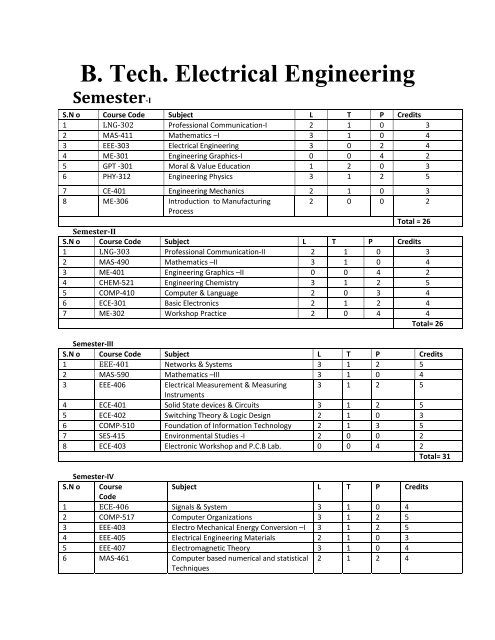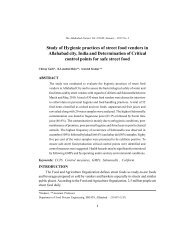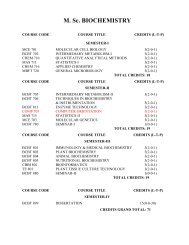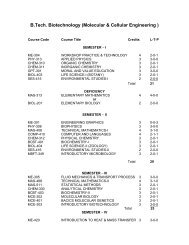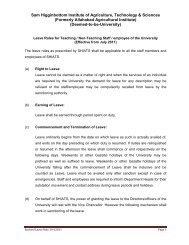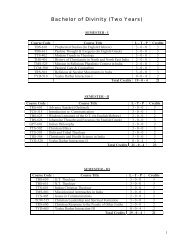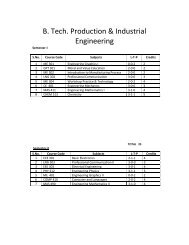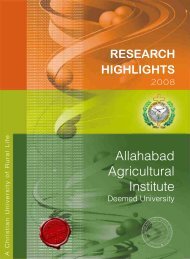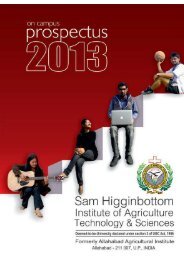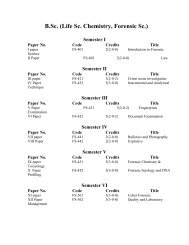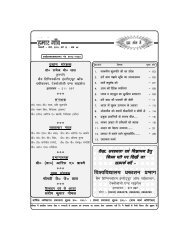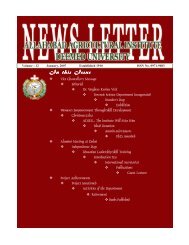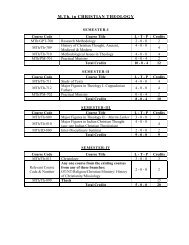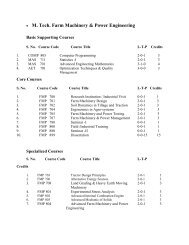B. Tech. Electrical Engineering - Shiats.edu.in
B. Tech. Electrical Engineering - Shiats.edu.in
B. Tech. Electrical Engineering - Shiats.edu.in
- No tags were found...
Create successful ePaper yourself
Turn your PDF publications into a flip-book with our unique Google optimized e-Paper software.
B. <strong>Tech</strong>. <strong>Electrical</strong> <strong>Eng<strong>in</strong>eer<strong>in</strong>g</strong>SemesterIS.N o Course Code Subject L T P Credits1 LNG‐302 Professional Communication‐I 2 1 0 32 MAS‐411 Mathematics –I 3 1 0 43 EEE‐303 <strong>Electrical</strong> <strong>Eng<strong>in</strong>eer<strong>in</strong>g</strong> 3 0 2 44 ME‐301 <strong>Eng<strong>in</strong>eer<strong>in</strong>g</strong> Graphics‐I 0 0 4 25 GPT ‐301 Moral & Value Education 1 2 0 36 PHY‐312 <strong>Eng<strong>in</strong>eer<strong>in</strong>g</strong> Physics 3 1 2 57 CE‐401 <strong>Eng<strong>in</strong>eer<strong>in</strong>g</strong> Mechanics 2 1 0 38 ME‐306 Introduction to Manufactur<strong>in</strong>gProcess2 0 0 2Total = 26SemesterIIS.N o Course Code Subject L T P Credits1 LNG‐303 Professional Communication‐II 2 1 0 32 MAS‐490 Mathematics –II 3 1 0 43 ME‐401 <strong>Eng<strong>in</strong>eer<strong>in</strong>g</strong> Graphics –II 0 0 4 24 CHEM‐521 <strong>Eng<strong>in</strong>eer<strong>in</strong>g</strong> Chemistry 3 1 2 55 COMP‐410 Computer & Language 2 0 3 46 ECE‐301 Basic Electronics 2 1 2 47 ME‐302 Workshop Practice 2 0 4 4Total= 26Semester‐IIIS.N o Course Code Subject L T P Credits1 EEE‐401 Networks & Systems 3 1 2 52 MAS‐590 Mathematics –III 3 1 0 43 EEE‐406 <strong>Electrical</strong> Measurement & Measur<strong>in</strong>g 3 1 2 5Instruments4 ECE‐401 Solid State devices & Circuits 3 1 2 55 ECE‐402 Switch<strong>in</strong>g Theory & Logic Design 2 1 0 36 COMP‐510 Foundation of Information <strong>Tech</strong>nology 2 1 3 57 SES‐415 Environmental Studies ‐I 2 0 0 28 ECE‐403 Electronic Workshop and P.C.B Lab. 0 0 4 2Total= 31Semester‐IVS.N o CourseSubject L T P CreditsCode1 ECE‐406 Signals & System 3 1 0 42 COMP‐517 Computer Organizations 3 1 2 53 EEE‐403 Electro Mechanical Energy Conversion –I 3 1 2 54 EEE‐405 <strong>Electrical</strong> <strong>Eng<strong>in</strong>eer<strong>in</strong>g</strong> Materials 2 1 0 35 EEE‐407 Electromagnetic Theory 3 1 0 46 MAS‐461 Computer based numerical and statistical<strong>Tech</strong>niques2 1 2 4
7 SES‐ 416 Environmental Studies ‐II 2 0 0 2Total= 27Semester‐VS.N o CourseSubject L T P CreditsCode1Elements of Economics & Pr<strong>in</strong>ciple of 3 1 0 4BAM‐315 Management Science2 EEE‐501 Electro Mechanical Energy Conversion –II 3 1 2 53 EEE‐502 Control System‐I 3 1 2 54 EEE‐503 Elements of Power System 3 1 0 45 ECE‐504 Electronics Circuit Design 3 1 2 5Total= 23Semester‐VIS.N o CourseSubject L T P CreditsCode1Power Electronics 3 1 2 5EEE‐5042 EEE‐505 <strong>Electrical</strong> <strong>Eng<strong>in</strong>eer<strong>in</strong>g</strong> Draw<strong>in</strong>g 0 0 3 23 ECE‐405 Microprocessor& Application 3 1 2 54 EEE‐506 Power System Analysis 3 1 0 45 EEE‐507 Power Station Practice 2 1 0 36 EEE‐508 Utilization of <strong>Electrical</strong> Energy & Traction 3 1 0 47 EEE‐580 Sem<strong>in</strong>ar ‐I 0 0 2 1Total= 24Semester‐VIIS.N o CourseSubject L T P CreditsCode1 EEE‐610 Non‐ Conventional Energy Sources 3 1 0 42 EEE‐605 Advance <strong>Electrical</strong> Mach<strong>in</strong>e 3 1 0 43 EEE‐601 Switch Gear & Protection 3 1 2 54 EEE‐602 Pr<strong>in</strong>ciples of <strong>Electrical</strong> Mach<strong>in</strong>e Design 3 1 2 55 EEE‐603 Modern Control System 3 1 0 46Industrial Tra<strong>in</strong><strong>in</strong>g 0 0 4 2EEE‐ 5007 EEE‐ 680 Sem<strong>in</strong>ar ‐II 0 0 2 18 EEE‐699 (A) Project(Project Formulation )0 0 4 2Total =27Semester‐VIIIS.N o Course Code Subject L T P Credits
2. Vector CalculusInterpretation of Vectors & scalars, Gradient, divergence and cur1 of a vector and theirPhysical <strong>in</strong>terpretations. Gauss Divergence theorem and stokes theorem.3. Differential CalculusLeibnitz theorem partial differentiation, Euler’s theorem. Asymptotes, Curve trac<strong>in</strong>gEnvelopes and evaluates. Change of variables, Jacobian, expansion of function of oneAnd several variables .Cyl<strong>in</strong>drical and spherical coord<strong>in</strong>ate system, Approximation ofErrors, Extreme of function of several variables, Lagrange’s method.4. Probability and StatisticsB<strong>in</strong>omial distribution, Normal distribution and Poison distribution, correlation and regressionReference;1. Shanti Narayan: A Text book of Matrices, S. Chand & Co.2. Thomasl F<strong>in</strong>ney: Calculus and Analytic Geometry, Narosa pub. House.3. J.N. Kapur: Mathematical Statistics, S. Chand & Co.4. C. Prasad: Mathematies for Eng<strong>in</strong>eers, Prasad Mudranalaya.ELECTRICAL ENGINEERING2)4Course code : EEE‐303Credits(3‐0‐1 S<strong>in</strong>usoidal Steady State circuit Analysis:Voltage , Current, S<strong>in</strong>usoidal & Phasor representation 1 Phase A.C. Circuit behavior of Resistance,Inductance.And Capacitance and their comb<strong>in</strong>ation, impedance concept of power , power factor, series ¶llel resonance – band width and quality factor.2. Network theory:Introduction to basic physical laws, Network theory, Theven<strong>in</strong> , Norton, Maximum Powertransfer theorems,Star‐ delta transformation, Circuit theory Concepts : Mesh and nodal analysis3. Three phase supply:Star/ delta connections, l<strong>in</strong>e and phase voltage / current relations , three phase power and itsmeasurement.4. Basic Instruments:Instruments for measurement of voltage, Current, power and energy: Construction , pr<strong>in</strong>cipaland application.5. Magnetic Circuit And Transformer:Magnetic circuit concept, Theory and work<strong>in</strong>g pr<strong>in</strong>ciple of s<strong>in</strong>gle phase transformer.6. Rotat<strong>in</strong>g Mach<strong>in</strong>es:Pr<strong>in</strong>ciples of energy conversion, Basic concepts of rotat<strong>in</strong>g mach<strong>in</strong>es, DC Mach<strong>in</strong>es, Differenttypes and theirCharacteristics & application, Elementary idea of operation of synchronous and <strong>in</strong>ductionmach<strong>in</strong>es. S<strong>in</strong>glePhase <strong>in</strong>duction & stepper motors, Applications.Reference:1.V. Del Toro: Pr<strong>in</strong>ciples of <strong>Electrical</strong> Engg –PHI.2.W. H Hayt & J.E Kennedy : Engg. Circuit Analysis, Mc Graw Hill.3.I.J Nagrath : Basic <strong>Electrical</strong> Engg. Tat Mc Graw Hill.4.A.E Fitzgerald : Electronic Instruments & Measurement techniques, PHI.List of experiments
1.Verify the Norton’s theorem.2.Verify the Theven<strong>in</strong>’s theorem.3.Verify the Superposition theorem.4.Verify the Kirchoff’s theorem.1. To f<strong>in</strong>d the Impedance and power factor <strong>in</strong> a RLC Series Circuit.2. To f<strong>in</strong>d the Impedance and power factor <strong>in</strong> a RLC Parallel Circuit.3. To Plot the resonance curve between Current and frequency <strong>in</strong> RLC series circuit byfrequency variation.4. To perform open circuit and short circuit test on, a s<strong>in</strong>gle‐ phase transformer.5. To draw magnetiz<strong>in</strong>g curve of a s<strong>in</strong>gle‐ phase transformer.6. To f<strong>in</strong>d the relation <strong>in</strong> Star & Delta connection.7. To calibrate a given energy meter with the help of Wattmeter and Load.ENGINEERING GRAPHICS‐1Course code : ME‐ 301Credits(0‐0‐3)21.IntroductionGraphics as a tool to communicate ideas, letter<strong>in</strong>g and dimension<strong>in</strong>g. Construction ofgeometrical figures like pentagon and hexagon .2.Orthographic ProjectionPr<strong>in</strong>ciples of orthographic projection, pr<strong>in</strong>cipal and auxiliary planes,First and third angle projections. (1)Projection of po<strong>in</strong>ts, pictorial view . (1)Projections of l<strong>in</strong>es parallel to both the plane. Parallel to one and <strong>in</strong>cl<strong>in</strong>ed to other, <strong>in</strong>cl<strong>in</strong>edto both thePlanes Application to practical problems. (3)Projection of sqlid 1h simple position , Axis or slant edge <strong>in</strong>cl<strong>in</strong>ed to one and parallel to otherplane,Solids ly<strong>in</strong>g on a face or generator on a plane. (2)Section<strong>in</strong>g of solids ly<strong>in</strong>g <strong>in</strong> various positions, true shape of the section. (2)Development of lateral surfaces, sheets metal draw<strong>in</strong>g. (1)3.Isometric ProjectionPr<strong>in</strong>ciples of isometric projection,Isometric projection us<strong>in</strong>g box andOffset methods. (2)References;1. Bhatt. N.D.: Elementary <strong>Eng<strong>in</strong>eer<strong>in</strong>g</strong> Draw<strong>in</strong>g , Charothar Publish<strong>in</strong>g.2. Lamxi Narayan V & Vaish W.: A textbook of practical Geometry on geometrical draw<strong>in</strong>g.MORAL AND VALUE EDUCATIONCourse code : GPT‐301 Credits(2‐0‐0) 2My country and my people, the many Indians, Be<strong>in</strong>g and becom<strong>in</strong>g an Indian, Nationalism andInternationalismSome life issues‐ love, Sex and Marriage, men and money‐ value of time, mean<strong>in</strong>gOf work Human Communication, human Suffer<strong>in</strong>g, Addiction, Ecology,Women’s Issues Corruption
Understand<strong>in</strong>g One’s neighbor. Neighborhood groups : their structure and functions.Patterns of Social <strong>in</strong>teraction of group dynamicsPreparation for a career, Choice of vocation, Motivation for study andResearch, the present <strong>edu</strong>cational system: Curriculum and Syllabus,Teach<strong>in</strong>g Methods, exam<strong>in</strong>ation and work experience.Def<strong>in</strong>ition of value Education, Moral and Ethics, laws and Morale Based on TenCommandments and two great commandmentsDiscovery of Self, Self‐ Awareness Growth of Intellect‐ man’s SpiritualNature Emotions, Will respect the right of life, Liberty, property, Truth reputation.S<strong>in</strong>, Orig<strong>in</strong> of S<strong>in</strong>, Manifestation of S<strong>in</strong>, The results of S<strong>in</strong>, the remedy ofS<strong>in</strong> , S<strong>in</strong> as an act, S<strong>in</strong> as a State, S<strong>in</strong> as a nature.Conscience – as def<strong>in</strong>ed <strong>in</strong> Oxford Dictionary and W<strong>in</strong>ston dictionary. Type of Consciousness (Suchas Evil, Convicted , purged, pure, Weak, Good, Void of Offence )5Course code : PHY‐312ENGINEERING PHYSICSCredits(3‐1‐2)1. Special Theory of RelativityMichelson Morley experiment, Inertial frames of reference, postulates of special theory ofrelativity,Lorentz transformation equation of space and time, length contraction, time dilation . Addition ofvelocities, variation of mass with velocity, mass energy equivalence.2. OpticsInterference : coherent sources , conditions of <strong>in</strong>terference, Fresnel’s biprism experiment, AndDisplacement of fr<strong>in</strong>ges, <strong>in</strong>terference <strong>in</strong> th<strong>in</strong> films wedge‐ shaped – film, Newton’s r<strong>in</strong>gs.Diffraction: s<strong>in</strong>gle slit and doubles sit diffraction, diffraction grat<strong>in</strong>g, and Raleigh’s criterion oflimit of Resolution, resolv<strong>in</strong>g power of telescope, microscope and grat<strong>in</strong>gPolarization : polarization of, light , pictorial representation of polarized light , Brewster’s law ,Malus law, phenomenon of double refraction, Geometry of calcite crystal,Optic axis. Pr<strong>in</strong>cipalSection , Ord<strong>in</strong>ary and extra‐ ord<strong>in</strong>ary rays, construction And work<strong>in</strong>g of Nicole, circularly andelliptically polarized light, retardation Plates, Production and analysis of plane, optical activity,Specific orientation, Polarimeter.3. FieldsScalar and vector fields gradient of scalar field, divergence & curl of a vector field, l<strong>in</strong>e Integral,conservative vector field , Gauss divergence theorem, stoke’s theorem.4. ElectrostaticsGauss ‘ law and it’s applications, Poisson and Laplace equations .Maxwell’s Equations, basicConcept of electromagnetic Waves and its solution <strong>in</strong> Free space.5 .Magnetic Properties 6f MaterialsPara, dia , Ferro, antihero and ferro – magnetie materials , hysteresis , Methods of plott<strong>in</strong>ghysteresis curve of a ferromagnetic materials and their uses, magnetic circuits.6. X‐Ray’sOrig<strong>in</strong> of X‐rays, cont<strong>in</strong>uous and characteristic X‐ ray spectra, Moseley’s law, Absorption of x‐rays, diffraction of X‐rays, Bragg’s law, Bragg’s spectrometer, practical applications of X‐ rays,Compton effects. (4)7.Quantum TheoryWave particle duality, de Broglie concept of matter Waves, Davisson and Germer experiment,Heisenberg uncerta<strong>in</strong>ty pr<strong>in</strong>ciple, Schrod<strong>in</strong>ger Wave equation and its solution.
8. LaserSpontaneous and stimulated emission of radiation, E<strong>in</strong>ste<strong>in</strong>’s coefficients, Ma<strong>in</strong> components of alaser, types of lasers and their applications.Reference1. Arthur Beiser: ‘ Colilcept of modem physics, TMH.2. Subrahmanyam & Brij Lal: A Text Book of Optics S. Chand & Co.3. K.K. Tiwari: Electricity & Magnetism, S. Chand & Co.4. Brij Lal & Subrahmanyam: Electricity & Magnetism.5. Wehr, Richardo & Adair: physics of the Atom.ENGINEERING MECHANICSCourse Code : CE –401Credits(2‐1‐0)31. Force and equilibriumBasic Concepts, force Moment and couple , Pr<strong>in</strong>ciple of transmissibility, Verigonon’s theorem,resultant of force Systems concurrent and Non‐ concurrent coplanar Force, funicular polygons.Free body diagram. (4)2.TrussesPlane structures, Various method of analysis of Trusses, method of jo<strong>in</strong>ts, Method of sections andGraphicalmethod. (5)3.Moment of <strong>in</strong>ertiaCenter of gravity, centroids of l<strong>in</strong>e, Area, volume and composite Bodies, Area moment of <strong>in</strong>ertiaand Massmoment of Inertia for plane figures and bodies <strong>in</strong>clud<strong>in</strong>g – composite Bodies, Product Moment of<strong>in</strong>ertia,parallel axis theorem. Pr<strong>in</strong>cipal moment of <strong>in</strong>ertia. (5)4.Friction<strong>in</strong>troduction, Dry friction, co‐efficient of static friction. Friction cone, Screw jack and belt friction.(3)5.BeamsBend<strong>in</strong>g moment and shear force diagrams for statically determ<strong>in</strong>ate beams. (5)6. K<strong>in</strong>ematics of Rigid Bodiesplane motion, Absolute motion , Relative motion, Translat<strong>in</strong>g axes and rotat<strong>in</strong>g axes . (6)7. K<strong>in</strong>etics of Rigid BodiesPlane motion, force, Mass and acceleration, work and energy, Impulse and momentum, pr<strong>in</strong>ciplesof energy conservation, pr<strong>in</strong>ciple of Virtual work, D’ Alembert’s Pr<strong>in</strong>cipal and dynamic equilibrium.(8)Reference :1. Beer. F.P. and Johnston, F.R.: Mechanics for eng<strong>in</strong>eers , Mc Graw Hill.2. Meriam, J.L.: Statics, john Wiely3.Meriam, J.L.: Dynamics, John Wiley4.Shames, I.H.: <strong>Eng<strong>in</strong>eer<strong>in</strong>g</strong> Mechanics , Prentice Hall of India’5.Dayaratnam, p.: Statics, Tata Mc Graw Hill.Professional Communication – II
COURSE CODE :LNG‐303CREDITS(2‐1‐0)3<strong>Tech</strong>nical Written Communication(a) Nature, orig<strong>in</strong> and development of technical written communication.(b) Salient features (3)(c) Difference between technical writ<strong>in</strong>g and general writ<strong>in</strong>g. Pre‐ requisites of Scientific and<strong>Tech</strong>nical Communication(a) Fragmented sentences(b) Parallel comparisons.(c) Elements of a series(d) Squ<strong>in</strong>t<strong>in</strong>g construction and split <strong>in</strong>f<strong>in</strong>itive.(e) Modifiers, connectives, antecedents and clause subord<strong>in</strong>ation(f) Dangl<strong>in</strong>g participles and gerunds(g) Ellipsis(h) Coherence, Unity, chronological method, spatial method, <strong>in</strong>ductive method, L<strong>in</strong>ear(i) Method, d<strong>edu</strong>ctive method, <strong>in</strong>terrupted method.Bus<strong>in</strong>ess Correspondent.(a) General pr<strong>in</strong>ciples of bus<strong>in</strong>ess correspondence(b)Ramifications, of bus<strong>in</strong>ess letters.(c) Letters giv<strong>in</strong>g <strong>in</strong>structions, <strong>in</strong>quiries and answers to <strong>in</strong>quires, compla<strong>in</strong>ts and adjustments, lettersurg<strong>in</strong>g action, employment letters,Application and resumes. (3)Proposal Writ<strong>in</strong>g.(a) Proposal : Def<strong>in</strong>ition and k<strong>in</strong>ds.(b) Division of format proposals (front matter, title page, summary abstract, Table of Contents etc..)(c) Statement of request, body‐ statement of problem, background, scope, methodology,(d) Advantages and disadvantages. (5)Writ<strong>in</strong>g Scientific, and Semi –technical articles(a) Source material, topic sentence, literature review(b) Tables, figures footnotes, bibliography.Prescribed text books for detailed study(i) Arora, V.n. (etal), Improve your writ<strong>in</strong>g (Delhi: oxford University Press, 1981.)(ii) Lesson No. 1.2,1.6, 2.4, 2.6, 3.5, 4.1, 4.3, 5.1, 5.4, 6.2, (6)ENGINEERING MATHEMATICS—IICourse code : MAS‐ 490 Credits(3‐1‐0 ) 41.Multiple <strong>in</strong>tegralDouble and triple <strong>in</strong>tegrals Change of order of <strong>in</strong>tegration, Change, of variables, ApplicationTo area: volume , center of gravity, moment – of <strong>in</strong>ertia and product of <strong>in</strong>ertia. Gamma andBeta function, Drichlet’s <strong>in</strong>tegral and its application. (8)2.Fourier SeriesPeriodic functions, Fourier series of functions with period 2n, Range of <strong>in</strong>terval, Half rangeS<strong>in</strong>e and cos<strong>in</strong>e series, (4)3.Integral Transform’Laplace transforms, Existence theorem, Laplace transform derivatives, InverseLaplace transforms, Application to solve l<strong>in</strong>ear differential equations, Unit‐ step function,Dirac delta function, Laplace transform of periodic functions, Applications of Laplace
Transforms, I Defii’litions of Fourier and z transform and its simple applications. (10)4. Ord<strong>in</strong>ary Differential EquationsIntroduction to order, degree and arbitrary constant, l<strong>in</strong>ear differential equations of n’ orderWith constant coefficients, Complimentary functions and particular <strong>in</strong>tegrals. HomogeneousDifferential equations, Simultaneous l<strong>in</strong>ear differential equations, Solution of second orderDifferential equation by chang<strong>in</strong>g, dependent and <strong>in</strong>dependent variables, Method ofVariation –of parameters, Equation_ of the form y” = f (y). Applications to eng<strong>in</strong>eer<strong>in</strong>gProblems. `(10)5.Solution of Equations and Curve Fitt<strong>in</strong>gSolution of cubic and bi –quadratic equations. Met Rod of least squares and Curve Fitt<strong>in</strong>g.(4)References:1. (E. _ Kreyszig: Advanced Eragil: Jeer<strong>in</strong>g mathematics, Wiley Eastern‘Ltd..2.B.S. Grewal: Higher <strong>Eng<strong>in</strong>eer<strong>in</strong>g</strong> mathematics, Khanna Publishers.3.Jaggi & Mathur: Advanced <strong>Eng<strong>in</strong>eer<strong>in</strong>g</strong> Mathematics, Khanna Pub.4.C. Prasad: Advansed Mathematics For Eng<strong>in</strong>eersENGINEERING GRAPHICS IICourse Code: ME‐401Credit:(0‐0‐3)1.Introduction:Graphic language, Classification of draw<strong>in</strong>gs, pr<strong>in</strong>ciples of draw<strong>in</strong>g: IS codes for Mach<strong>in</strong>eDraw<strong>in</strong>g ,l<strong>in</strong>es, Scales, Sections, Dimension<strong>in</strong>g, Standard abbreviations.2.Orthographic Projections:Pr<strong>in</strong>ciples of first and third angle projections, draw<strong>in</strong>g and sketch<strong>in</strong>g of mach<strong>in</strong>e elements <strong>in</strong>Orthographic projections, spac<strong>in</strong>g of views.3. Screwed (Threaded ) Fasteners:Introduction, Screw thread nomenclature, forms of threads, Thread series, ThreadDesignation. Representation of threads, Bolted Jo<strong>in</strong>ts, Lock<strong>in</strong>g arrangements, FoundationBolts.4. Keys and Cotters: Keys, Cotter Jo<strong>in</strong>ts.5. Shaft Coupl<strong>in</strong>gs: Introduction, Rigid and flexible coupl<strong>in</strong>g.6. Riveted Jo<strong>in</strong>ts: <strong>in</strong>troduction, Rivets and rivet<strong>in</strong>g, Rivet heads Classification of riveted7. Assembly draw<strong>in</strong>g : Introduction, Eng<strong>in</strong>e parts, Stuff<strong>in</strong>g box etc.8. Fee hand sketch<strong>in</strong>g: Introduction, Need for freehand sketch<strong>in</strong>g, Free hand ofSketch<strong>in</strong>g of some threaded fasteners and simple mach<strong>in</strong>e
Components..Reference_:1. N. Siddeshwar, p. Kannaiah, V.V.S. Shastry: Mach<strong>in</strong>e draw<strong>in</strong>g , TMH, New Delhi.2. K.L Narayana, P. Kannaiah, K. VenkatReddy: Mach<strong>in</strong>e draw<strong>in</strong>g , New Age International Publication_‐2 nd edition.3. <strong>Eng<strong>in</strong>eer<strong>in</strong>g</strong> draw<strong>in</strong>g practice for schools and’ colleges, SP46‐1998 (B18)COMPUTER AND LANGUAGESCourse Code:COMP‐410 Credits:(2‐0‐2) 4Computer hardware components and their functionsBasic operat<strong>in</strong>g system conceptsMSDOS and gett<strong>in</strong>g to know DOS commandsFamiliariz<strong>in</strong>g with WINDOWS environmentGett<strong>in</strong>g started with UNIXFiles & Directories and their use <strong>in</strong> different Operat<strong>in</strong>g System EnvironmentsGett<strong>in</strong>g to know different editors edit & viIntroduction to InternetGett<strong>in</strong>g familiar with Browser programme Netscape & ExplorerSend<strong>in</strong>g & receiv<strong>in</strong>g mail over InternetIntroduction of PINE and /of ELMWhat is a programm<strong>in</strong>g language?How Programs are developed and executed?Introduction to “C” Programm<strong>in</strong>g languageBasic “c” features: Arithmetic & logical expressionsAdvanced “C” features: conditional & loopsFunction & ArraysIntroduction to Po<strong>in</strong>ters & StructuresReferences:1. DOS the complete reference by Kris Jamsa, Tata‐ Mc Graw Hill Publication.2. UNIX POWER TOOLS by J. Peek Tim O’ reilly & M. Locekides, BPB Publication.3. The “C” Programm<strong>in</strong>g Language by B.W Kernighan & D.M Ritchie, Prentice Hall of India.4. Us<strong>in</strong>g LINUX‐ Latest Edition By Jade Tackett & David Ganter, Prentice Hall of India.ENGINEERING CHEMISTRYCourse Code:CHEM‐521Credit(3‐1‐1) 51. General ChemistryAdvanced Theory of Chemical Bond<strong>in</strong>g: Valence bond and molecular orbital theory. Structure of NH3,HP, SO3 Pc15, XeO2 molecules, Theories of bond<strong>in</strong>g <strong>in</strong> metals and semi, ‐ conductors, n‐type And p‐type semiconductors, Imperfections <strong>in</strong> materials. Born‐ Haber cycle, Bragg’s conditions.(4)2. Physical ChemistryEquilibrium on Reactivity: Bronsted and Lews Acids, pH, pKa, pKb Seale, Buffer solution.Stereochemistry of organic compounds, co‐ord<strong>in</strong>ation chemistry, Nomenclature, Valence bond andCrystal field theory. (3)
P‐N Junction, depletion layer, v‐I characteristic, diode resistance, capacitance, switch<strong>in</strong>g time, diodeapplication as rectifier (half wave and full wave), diode circuits (clipper, clamper, voltagemultipliers) Breakdown mechanism, Zener & avalanche, breakdown characteristics, Zener diodeand its applications.4. Bijunction transistor:Bipolar junction transistor , CE, CC& CB configuration., characteristic curves (cut off , active andsaturation region, requirement of bias<strong>in</strong>g and bias<strong>in</strong>g types and bias<strong>in</strong>g analysis, Stability.5. Transistor as Amplifiers;Graphical analysis of CE amplifier, Concept of voltage ga<strong>in</strong>, current ga<strong>in</strong> and power ga<strong>in</strong> h‐parameter(low frequency), computation of Av Ri, & and approximate formulae.6. Operational Amplifiers:Concepts of ideal op‐ amp, <strong>in</strong>vert<strong>in</strong>g, non <strong>in</strong>vert<strong>in</strong>g and unity ga<strong>in</strong> amplifiers, adders, Differenceamplifier, <strong>in</strong>tegrator.7. Switch<strong>in</strong>g Theory & Logic GatesMillimeter, CRO and its applicationsBooks recommended1.Boylstad & Neshlshky, “Electronic Devices & Circuits,” PHI.2.Moris Mano, “Digital Computer Design” PHI.WORKSHOP PRACTICECourse Code :ME –302Credits:(2‐0‐4) 41.IntroductionClassification of manufactur<strong>in</strong>g processes, primary shap<strong>in</strong>g processes,. Mach<strong>in</strong><strong>in</strong>g processes,Jo<strong>in</strong><strong>in</strong>g processes, Surface f<strong>in</strong>ish<strong>in</strong>g processes, Plant & shop layout , Industrial safety. (1)2.Properties of MetalsStrength, Elasticity, Stiffness, Plasticity , Malleability , Ductility , Brittleness, Toughness, Hardness,Impact strength , Fatigue , Creep.(1)3.Classification of MetalsWrought iron, Cast iron, Gray cast iron, White cast iron , Nodular cast iron , Alloy cast iron, SteelMild steel, Medium carbon steel . High carbon steel and its applications . Effect of Alloy<strong>in</strong>g elementson steel, Special alloy steels, e.g. sta<strong>in</strong>less steel , high speed steel, Cutt<strong>in</strong>g alloys.(2)4. Non‐ Ferrous MetalsAlum<strong>in</strong>um, copper, Z<strong>in</strong>c, Lead, T<strong>in</strong>, Nickel, non‐ ferrous alloys, Brass, Bronze.(2)5.Carpentry ShopIntroduction, Selection of timber. Season<strong>in</strong>g of Timber, Common defects <strong>in</strong> Timber, Preservation oftimber , Auxiliary materials used <strong>in</strong> carpentry, Veemers and veneer<strong>in</strong>g, Plywood, wood’ Mark<strong>in</strong>ghand tools, Mark<strong>in</strong>g and measur<strong>in</strong>g tools, Hold<strong>in</strong>g & Support<strong>in</strong>g tools, Cutt<strong>in</strong>g tools‐Saw, Chisel,Planers, Bor<strong>in</strong>g tools, Wood’ mark<strong>in</strong>g Processes, Jo<strong>in</strong>ery work classification of jo<strong>in</strong>ts.(3)6.Bench Work<strong>in</strong>g & Fitt<strong>in</strong>g ShopIntroduction, Vices, vice blocks, Surface plates, Trisquare, Bevel square, Comb<strong>in</strong>ation setfiles,Chisels, Hacksaw , Surface gauge, Universal surface gauge, punches, Calipers, Dividers, pliers,Spanners, Drills taps. Die and die stock. Screw pitch gauge, Wire gauge, Dial <strong>in</strong>dicator , Bench’Mark<strong>in</strong>g Processes. (2)
7.Weld<strong>in</strong>g ShopConcept of weld<strong>in</strong>g, Resistance weld<strong>in</strong>g, Spot weld<strong>in</strong>g resistance butts and flashes weld<strong>in</strong>g,Resistance projection weld<strong>in</strong>g and seam weld<strong>in</strong>g , Electric are weld<strong>in</strong>g , Gas Weld<strong>in</strong>g (Oxy‐ Acetyleneweld<strong>in</strong>g),Equipment’s and process, weld<strong>in</strong>g jo<strong>in</strong>ts and positions of weld<strong>in</strong>g.(2)8. Sheet MetalIntroduction, Metals used <strong>in</strong> sheet metal shop hand tools, sheet metal operations.(1)NETWORKS & SYSTEMSCourse Code:EEE‐401Credit(3‐1‐2) 51.Introduction to Graph Theory:Def<strong>in</strong>itions, graph, tree, spann<strong>in</strong>g, walk, trail, path, loop, co‐ tree, basic cut set And loop & cut setmatrices for planar networks, loop and nodal method of analysis.2.Introduction to cont<strong>in</strong>uous time signals and systems.Basic cont<strong>in</strong>uous time Signals, unit step, ramp and impulse, differential equation Formulation forl<strong>in</strong>ear‐Time <strong>in</strong>variant (LTI )3. Review of Laplace transform (LT),Initial value and f<strong>in</strong>al value theorem, properties and solution of differential equations us<strong>in</strong>g LT,waveform synthesis and LT of complex waveforms: concept of transform impedance.4. Net work Theorems:Pr<strong>in</strong>ciple of superposition, Tellegen’s theorem, Theven<strong>in</strong>, Norton, Millman, Maximum powertransformer, Block diagram representation of L T I cont<strong>in</strong>uous Time networks and systems, Timedoma<strong>in</strong>analysis of L T I network us<strong>in</strong>g Laplace Transform (transient and steady state), relationbetween impulse response and system function.5.Concept of poles and zeros ,Relation between location of poles, time‐ response and Stability, frequency response and bodeplots, <strong>in</strong>terrelation between frequency Response and time response, convolution <strong>in</strong>tegral.6.Two port networks,Two‐port parameters, <strong>in</strong>ter‐conversion of 2‐ port parameters, Network functions: driv<strong>in</strong>g po<strong>in</strong>tand transfer, <strong>in</strong>terconnection of 2‐ port networks, Reciprocity, ladder networks, imageimpedance, characteristics impedance, T‐ π Transformation.7. Position real function:Def<strong>in</strong>ition and properties, Synthesis of LC,RL, and RC Us<strong>in</strong>g Cauer’s and Foster’s first andsecond form.Book Recommended1. M.E. Van Valkenburg’ Network Analysis, ’Prentice Hall2. J.D. Ryder,’ Networks Fields and Transmission L<strong>in</strong>es,’ Prentice Hall.3. W.H. Hayt & E. Kemmerly,’ <strong>Eng<strong>in</strong>eer<strong>in</strong>g</strong> circuit Analysis,’TMH.4. V.K. Aatre,’ Network theory & Filter Design,’ New Age International Pub.5. Nara s<strong>in</strong>gh Deo,’Graph Theory.’6. J.A. Edm<strong>in</strong>ister,’ Electric Circuits,’ Schaum series, McGraw Hill.List of experiments for Network & System1. Cascaded two port network.2. Tw<strong>in</strong> T network characteristics.3. Transient response of RLC series Circuit.4. Hybrid parameters of a transistor.5. Study of resonance <strong>in</strong> RLC series and parallel circuit and damp<strong>in</strong>g effects.6. Z and H Parameters.7. Maximum Power transfer theorem.
4ENGINEERING MATHEMATICSIIICourse Code: MAS –590 Credits (3‐1‐0)1. Ord<strong>in</strong>ary Y. Differential Difference Equations: 10ODE of 2 nd order with constant coefficients both homogeneous and non‐ homogeneous Types withapplications to electrical and mechanical systems. Difference equations and their Solutions by ztransform. Series solutions of ODE of 2 nd orders with variable Coefficients with special emphasis tothe differential equations of Legendre, Bessel and Chebyshev. Legendre’s polynomials, Chabyshevpolynomials and Bessel’s functions and Their properties.2. Integral Transforms: ‐6Fourier transform and <strong>in</strong>tegral Hanker transforms and Hilbert transforms and their Properties,some simple applications. Partial Differential Equations: L<strong>in</strong>ear PDE with constant coefficients of 2 ndorder and their classifications, PDE of Parabolic, elliptic and hyperbolic type with illustrativeexamples. Separation of variables Method for solv<strong>in</strong>g PDE. Such as two dimensional heatequations, wave equations and Laplace equations.3. Functions of a Complex variable: 15Analytic (functions, Gauchy‐ Riemam equations, harmonic functions l<strong>in</strong>e <strong>in</strong>tegral <strong>in</strong> the Complexplane, caucry’s Integral theorem cauchy’s <strong>in</strong>tegral formula derivatives of analytic Functions,Liouvilles Theorem, fundamental theorem of Algebra representation of a Function py power series,Taylor’s series and Laurent’s Series, poles, S<strong>in</strong>gularities and Zeros. Residue theorem, evaluation of<strong>in</strong>tegrals us<strong>in</strong>g. Residue theorem. Conformal” Mapp<strong>in</strong>g, l<strong>in</strong>ear fractional transformations, speciall<strong>in</strong>ear fractional transformations.Reference: s1 Kreyszig, E. (1993): Advanced Engg. Mathematics 7 th Edition, John Willey & sons <strong>in</strong>c.2 Paopoulis: Signal Analysis 3 rd Edition (1988) Me Graw Hill .Course code: EEE‐406 :Credit(3‐1‐2) 5ELECTRICAL MEASUREMENTS AND MEASURING INSTRUMENTS1. Philosophy of MeasurementAccuracy & Precision, errors <strong>in</strong> measurement, “types of measur<strong>in</strong>g Instruments with brief detail.2. Analog measurement of <strong>Electrical</strong> QuantitiesReview of various <strong>in</strong>struments for measurement of voltage and current Electro dynamo Meter and<strong>in</strong>duction wattmeter’s Measurement of power ‘<strong>in</strong> s<strong>in</strong>gle phase and –three phase Systems, errors and, remedies <strong>in</strong> wattmeter and , energy meter, <strong>in</strong>strument transformers And their application <strong>in</strong> theextension of <strong>in</strong>strument range, <strong>in</strong>troduction to measurement of Speed and frequency.3. Measurement of ParametersDifferent methods of measur<strong>in</strong>g low, medium and high resistances, measurement of Inductanceand capacitance with the help of a.c bridges, Q meter.4. D.C and A.C PotentiometerD.C and AC potentiometers and their applications.5. Magnetic MeasurementBallistic galvanometer and flux meter, determ<strong>in</strong>ation of hysteresis loop & measurement of Ironlosses6. Digital Measurement of <strong>Electrical</strong> Quantities
Concept of digital measurement, digital measurement of voltage, current, power, power factorand frequency: power analyzer, harmonics analyzer.References:1. E.W. Gold<strong>in</strong>g, & F.C. Widdis, <strong>Electrical</strong> measurement & Measur<strong>in</strong>g Instruments, A.H. Whealer & Co. Pvt.Ltd., India.2.Forest K.: Harris, <strong>Electrical</strong> Measurement’ Willey Eastern Pvt. Ltd, India.3. M.B. Stout, Basic <strong>Electrical</strong> Measurements’ Prentice hall of India , India.4.A.K. Sawhney, <strong>Electrical</strong> & Electronic Measurement & Instrumentation, Ohanpat Rai& Sons, I’ 1dia.5.W.D. Cooper, Electronic Instrumentation and Measurement technique, prentice hallInternationalSOLID STATE DEVICES & CIRCUITSCourse Code ECE‐401 Credits (3‐1‐2)51.Study of unregulated power supplies: Review of half and –full wave bridge rectifiers; Capacitor, L‐C,filters, bleeder resistance, ripple factor, diode rat<strong>in</strong>gs.2.Ebers‐moll model, cut off, active and saturation region of transistor. Review of transistor bias<strong>in</strong>g:stability analysis of bias<strong>in</strong>g, thermal runaway.3. Field effect transistor: Construction of JFET & MOSFET (Enhancement & depletion), characteristics,circuit symbols Bias<strong>in</strong>g ,FET as resistance, small signal model, FET amplifiers.4.Multistage amplifier: Effect of coupl<strong>in</strong>g and by‐pass capacitors, emitter follower at low frequency:Darl<strong>in</strong>gton Connection, source follower, cascade amplifier, bootstrapp<strong>in</strong>g, power amplifier: S<strong>in</strong>gle endedAnd push pull amplifiers, class B, class AB and class C power amplifiers, transformer Coupl<strong>in</strong>g andcapacitor coupl<strong>in</strong>g, conversion efficiency, power and heat s<strong>in</strong>ks.105.Small signal model: Hybrid‐TT model, Frequency response of a transistor amplifier ga<strong>in</strong> bandwidthproduct, Concept of fa’fT and fp, Wideband amplifier: compensation techniques, Cascade amplifiers,Introduction to tuned amplifiers.86. Feed Back Amplifiers and Oscillators: Pr<strong>in</strong>ciples of feed back <strong>in</strong> amplifiers advantages of negativefeedback, classification of Feedback :voltage‐series, voltage‐ shunt, current‐ series, current –shunt effectof feed back on Input and output impedance, ga<strong>in</strong>, stability, noice, distortion and bandwidth.Berkhausen Criterion for s<strong>in</strong>usoidal oscillators, oscillators, phase shift oscillator, We<strong>in</strong> bridge oscillator,Hartley & Colpitts oscillators, crystal oscillators, frequency stability.8Book Recommended:1. J. Millman & A. Grabel, “Microelectronics,’TMH.2. R. L Boylestad 7 L Nashelsky, ’Electronics Devices & Circuit Theory’ Prentice Hall.SWITCHING THEORY & LOGIC DESIGN
Course Code: ECE –402 Credits:(2‐1‐0) 31. Number System: Representation of negative numbers, 9’s and I ‘s complement, 1o’s 2’s complementArithmetic us<strong>in</strong>g 2,s complement, float<strong>in</strong>g po<strong>in</strong>t representation : range, resolutions, Normalization,representation of zero, unused codes, parity bit & error –detection.2.M<strong>in</strong>imisation of Boolean functions hav<strong>in</strong>g don’t care entries, m<strong>in</strong>imization Us<strong>in</strong>g tabular method.3.Comb<strong>in</strong>ation Circuits Design: Adders: serial and parallel, magnitude comparator, decoder, multiplexesand applications, hazards and its avoidance.4.Introduction to sequential logic:Concept of history sensitive circuits and feed back flip‐flops: RS, D, T,JK, and race around Condition, master slave flip‐flops. Analysis of clocked sequential betweenasynchronous and synchronous circuits. Design of synchronous circuits: state Transition diagram, form<strong>in</strong>gof universal map, excitation tables for flip flops, design us<strong>in</strong>g M<strong>in</strong>imization techniques, handl<strong>in</strong>g entry <strong>in</strong>toon desired state, power on reset.5.Design of asynchronous sequential circuits: Fundamental mode. Circuits synthesis us<strong>in</strong>g flow tables,excitation tables and output Tables, races (critical and non –critical ) and cycles and its avoidance.Book Recommended:1. M. Morris Mano, ’Digital Prentice Hall.2. Zvi Kohavi, ‘Switch<strong>in</strong>g & F<strong>in</strong>ite automate Theory], Prentice Hall.3. A.S. Tennenbaun, ‘Structured computer organization], Prentice Hall(For negative numberFOUNDATIONS OF INFORMATION TECHNOLOGYCourse Code:COMP‐510 Credit: (2‐1‐3)5Fundamental Concept Of InformationInformation Concept And Process<strong>in</strong>gDef<strong>in</strong>ition of lnformation, Need of Information ,Quality of Information , Value of Information, Concept ofInformation , Entropy Category and j” , evel of Information <strong>in</strong> Bus<strong>in</strong>ess Organization, Data Concepts andData Process<strong>in</strong>g , Data Representation.Information RepresentationInformation Contents, Introduction To Information Representation <strong>in</strong> digital Media, Text, Images,Graphics, Animation, Audio, Video elementary Concepts <strong>in</strong> <strong>in</strong>formation Preservence, Data Compression,Huffman Cod<strong>in</strong>g, Shannon Pr<strong>in</strong>ciples, Adaptive Compression, LZW Cod<strong>in</strong>g, Text, Images Compression,Introduction to Jpeg, Mpeg, Mheg.Computer and Programm<strong>in</strong>gComputer appreciationDef<strong>in</strong>ition of electronic computers history of computers, generation, characteristicsand Application of computers, classifications of computers RAM, Rom, computers hardware’s CPUvarious I/O devices peripherals and storage media, software def<strong>in</strong>itionProgramm<strong>in</strong>g Language Classification and Programmed MethodologyComputer languages generation of languages <strong>in</strong>troduction to 4 GLS, software development Methodologylife cycles, software cod<strong>in</strong>g, test<strong>in</strong>g, ma<strong>in</strong>tenance <strong>in</strong>dustry standards Introduction to ISO, SEI‐ CMMstandards for it <strong>in</strong>dustries.Digital devices and basic network conceptsDigital Fundamentals:Various codes, decimals, b<strong>in</strong>ary, hexadecimal conversion float<strong>in</strong>g numbers, gates , flip flops,m<strong>in</strong>imization, adder, multiplexers.Computers network and communication
Need for data transmission over distance, types of data transmission, media for dataTransmission,network<strong>in</strong>g of computers‐ <strong>in</strong>troduction of LAN and WAN, network topologiesBasic concept <strong>in</strong>computers and network client server architecture, <strong>in</strong>troduction to Advanced communicationtechniques ISDN ATM, token based protocol CSMA/CD, mobile Communication.Internet And Web technologiesInternet & World’ Wide Web’Hypertext markup Language DHJML, WWW, gopher, FTP Telnet, Web browsers, Net Surf<strong>in</strong>g searchEng<strong>in</strong>e, Basic concept <strong>in</strong> ‘E‐ commerce, EDI, Electronic payments, Digital Signatures, Network securitiesfirewall.Web <strong>Tech</strong>nologiesElementary concepts <strong>in</strong> object oriented programm<strong>in</strong>g, corba, COM/DCOM Wireless Application protocol,ASP, script<strong>in</strong>g HTML, Java APPLETS, WAP, WML, JSPIT Industry Jrends, Careers and ‘ Applications In IndiaScientific, Bus<strong>in</strong>ess, Educational and Enterta<strong>in</strong>ment applications , Industry Automation, Weather,forecast<strong>in</strong>g awareness of Ongo<strong>in</strong>g IT projects <strong>in</strong> India, NICNET ernet, Application of IT to E Commerce,Electronic Governance, Multimedia, Enterta<strong>in</strong>ment.Suggested Text Books & References:1.Curt<strong>in</strong>, ”Information <strong>Tech</strong>nology: Break<strong>in</strong>g News,”TM+12. Raja Raman, V.2.Introduction to Computers” 3. Bajpai, Kushwaha & Yadav,”3.Introduction to Computer & C Programm<strong>in</strong>g”, New Age <strong>in</strong>ternational.ENVIRONMETAL STUDIES‐ICourse Code:SES‐ 415 Credits: (2 0 0)1: The Multidiscipl<strong>in</strong>ary Nature of Environmental StudiesDef<strong>in</strong>ition, Scope and Importance(i) Ecosystems• Concept of an ecosystem• Structure and function of an ecosystem• Producers, consumers and decomposes• Energy flow <strong>in</strong> the ecosystem• Food cha<strong>in</strong>s, food webs and ecological pyramids• Introduction, types, Chacretistics features, structures and function of the follow<strong>in</strong>gecosystem:(a) Forest Ecosystem(b)Grassland Ecosystem(c) Desert Ecosystem(d) Aquatic ecosystem (Ponds, streams, lakes, rivers, oceans, estuaries.)(ii) Social Issues and the Environment• From Unsusta<strong>in</strong>able of susta<strong>in</strong>able development• Urban problems related to energy• Water conservation, ra<strong>in</strong> water harvest<strong>in</strong>g, water shed management• Resettlement and rehabilitation of people; Its problems and concerns Case studies• Environmental ethics: Issues and possible solutions• Climate change, global warm<strong>in</strong>g, acid ra<strong>in</strong>, ozone layer depletion, nuclearAccidents and holocaust, Case studies.• Wasteland reclamation.• Consumerism and waste products.• Environment protection Act• Air (Prevention and Control of Pollution ) Act• Visit to local polluted site‐ Urban/Rural/Industrial/ Agricultural• Study of Common plants, <strong>in</strong>sects, birds• Study of simple ecosystems – ponds, river. Hill slopes etc (Field work equal to 5 lecture hour
ELECTRONIC WORKSHOP & PCB Lab:Course Code: ECE –403(0‐0‐2) 21. W<strong>in</strong>d<strong>in</strong>g Shop:Step down transformer w<strong>in</strong>d<strong>in</strong>g of less then 5VA.. 3Solder<strong>in</strong>g Shop:Fabrication of DC unregulated power supply2. PCB Lab:(a) Artwork and pr<strong>in</strong>t<strong>in</strong>g of simple PCB.(b) Etch<strong>in</strong>g and drill<strong>in</strong>g of simple PCB.3. Wir<strong>in</strong>g and Fitt<strong>in</strong>g Shop:Fitt<strong>in</strong>g of power supply along with meter <strong>in</strong> a cab<strong>in</strong>et.4.Test<strong>in</strong>g of power supply fabricatedNote: no design work is <strong>in</strong>volvedSIGNALS & SYSTEMSCreditsCourse Code:ECE –406 Credits(3‐1‐0) 41. Cont<strong>in</strong>uous and Discrete time signals:Transformation of the <strong>in</strong>dependent variable, cont<strong>in</strong>uous discrete time systems, basic system properties. (3)2. Fourier Transform:Basic theorem, application to L T I networks frequency response, Fourier Series Representation ofperiodic non s<strong>in</strong>usoidal signals application to analysis of L T I networks.(4)3. Discrete time Fourier Transform:Representation of periodic signals, Fourier transform of periodic signals, Properties of DiscreteFourier transforms , convolution property , multiplication properties, duality.(5)4. Time and frequency characterization:Magnitude‐ phase representation of Fourier transform, frequency response of L T I systems, Timedoma<strong>in</strong> properties of ideal frequency selective, filters, time doma<strong>in</strong> and frequency Doma<strong>in</strong> aspectsof non‐ ideal filters, first order and second order, cont<strong>in</strong>uous and Discrete time systems.(8)5. Random Variables & ProcessRandom variable, random process, correlation function (auto & cross), cumulative Distributionfunction, probability density function, jo<strong>in</strong>t cumulative & distribution and probability density.(8)6. Sampl<strong>in</strong>g:Sampl<strong>in</strong>g theorem, reconstruction of signals from samples, effect of under sampl<strong>in</strong>g discrete timeprocess<strong>in</strong>g of cont<strong>in</strong>uous time signals.(4)7. Introduction to Z‐ TransformsConvergence, <strong>in</strong>verse, properties of z – transform (l<strong>in</strong>earity, time shift<strong>in</strong>g, scal<strong>in</strong>g reversal,Expansion, conjugation, convolution, differentiation <strong>in</strong> z‐ doma<strong>in</strong>, <strong>in</strong>itial value theorem), Analysis andcharacterization of L T I systems.(6)Books and references:1.A.V. Oppenheim, A.S. Willsky and S.H. nawab, ‘Signals and Systems,’ prentice Hail.2.B.P. Lathi, ‘Modern Analog and Digital Communication systems,’ Oxford University press, NewDelhi.3.S. Hayk<strong>in</strong>s,’ Communication Systems’ john Wiley.4. Taub & Schill<strong>in</strong>g, ‘Pr<strong>in</strong>ciples of Communication systems,’TMH.
COMPUTER ORGANISATIONCourse Code:COMP‐517 Credits (3‐1‐2)5Representation of Information:Number system, Integer and Float<strong>in</strong>g Po<strong>in</strong>t Representation, Character Codes Ascii, Ebcdic ErrorDetection and Correction Codes.Basic Build<strong>in</strong>g Blocks:Boolean Algebra, Comb<strong>in</strong>ation Logic Design, flip –flops, Registers, Counters, ALU.Arithmetic and LogicOperations, Faster Algorithm and their Implementation, Organization Of Central Process<strong>in</strong>g unit(Hardwired and Micro programmed), Microprogramm<strong>in</strong>g.Organization:Memory Types and Organization, Address Decod<strong>in</strong>g and Select<strong>in</strong>g , Peripheral Device‐s I/O Devices(Disks and Tapes). Programmed and Interrupt Control Mechanisms, I/O Controllers, DMA, BusArchitecture, Bandwidths, Assembly language programm<strong>in</strong>g, Programmers Models of A Mach<strong>in</strong>e.Theory of Parallelism:Parallel Computer Models, Pr<strong>in</strong>ciples of Performance & _ ca1ability, Processor & Memory Hierarchy,Cache and Shared Memory, multiprocessors, Flynn Classifications, parallel Comput<strong>in</strong>g , IntroductoryConcept of Pipel<strong>in</strong>e, Vector Process<strong>in</strong>g.Example of Typical 16 or 32 Bit Processor. Registers and Address<strong>in</strong>g Modes, Instruction Set; Use of andAssembly Language for Specific Programs for Typical Programs Like: Table Search, Subrout<strong>in</strong>es,Symbolic and Numeric Manipulations and I/O.Suggested Books & Reference:Hamacher,” Computer Organization”, Mc Graw Hill.Tannenbaum, “Structured Computer Organization” Prentice hall of India.ELECTRO-MECHANICAL ENERGY CONVERSION-ICourse Code:EEE‐ 403Credits(3‐1‐1) 5Pr<strong>in</strong>ciple of E.M.E.C:‘Introduction, Energy <strong>in</strong> Electro‐magnetic System “Flow of Energy <strong>in</strong> Electro Mechanical Devices, Energy <strong>in</strong>Magnetic field and co‐energy, dynamics of Electromechanical Systems, S<strong>in</strong>gly excited system, torque EMFequations, idealized mach<strong>in</strong>e, Need for d‐q‐oTransformation basic mach<strong>in</strong>e relations <strong>in</strong>. d‐q‐o variables.(8)D.C Mach<strong>in</strong>es:EMF and torque equations, Armature w<strong>in</strong>d<strong>in</strong>gs, Armature Reactions Demagnetiz<strong>in</strong>g _& Cross –magnetiz<strong>in</strong>g armature MMF. Interpol and Compensat<strong>in</strong>g w<strong>in</strong>d<strong>in</strong>gs, commutation, Characteristics of D.C.generators. (7)D.C motors and their characteristicStart<strong>in</strong>g of D.C motors. Starter step calculation of D.C. shunt motor & speed control of D.C Shunt motor,Ward Leonard control. Break<strong>in</strong>g of D.C. moors. Efficiency and test<strong>in</strong>g of D.C Mach<strong>in</strong>es, Hopk<strong>in</strong>son test.TransformersTransformer constructional & practical considerations Three –phase transformer, vector Group equivalentcircuit, Exact and approximate, per unit values phasor diagram Transformer test<strong>in</strong>g: open circuit test;Short circuit test Sumpner’s test, Efficiency andVoltage regulation, all day efficiency Auto transformer.3 to 2 and 6, phase conversion( 8)Harmonics
Three‐phase bank of s<strong>in</strong>gle transformers, parallel operations of 1 & 3 phase Transformers, load divisionbetween transformers <strong>in</strong> parallel. Three w<strong>in</strong>d<strong>in</strong>g transformers Tertiary w<strong>in</strong>d<strong>in</strong>g , Tap Chang<strong>in</strong>g,Transformers special. purposes, Weld<strong>in</strong>g, Traction. Instruments and pulse transformers(7)References:1.<strong>Electrical</strong> Mach<strong>in</strong>e: I.J. Nagrath and D.P. Kothari (Tata Mc Graw Mill)2.<strong>Electrical</strong> Mach<strong>in</strong>ery: Fitzerald, K<strong>in</strong>gsley (Mc Graw Hill).3.<strong>Electrical</strong> Mach<strong>in</strong>es and Their Application: J. Hundmarsh.4.Fundamental of <strong>Electrical</strong> Mach<strong>in</strong>es: B.R. Gupta & V. S<strong>in</strong>ghal(New Age International Pub.).List of practical for EMEC –I Lab1) Part of DC Mach<strong>in</strong>e2) Load test on DC shunt Generator.3) Load test on DC Series Generator.4) Load test on DC Compound Generator.5) Magnetization Characteristic of externally excited DC Shunt Generator.6) Load test on DC Shunt Motor.7) No load (Sw<strong>in</strong>burne’s test) test on DC Shunt Motor.8) Scott Connection on two identical transformers.9) Three phase AC to 2 two phase AC balanced load transformation.ELECTRICAL ENGINEERING MATERIALSCourse code: EEE‐405Credits(2‐1‐0) 31.Crystal Structure of MaterialsAtomic bond<strong>in</strong>g, Crystall<strong>in</strong>ity, Miller Indices X‐ray crystallography, structural imperfections,crystal growth.2.Conductivity of MetalsFree electron theory of metals, factors affect<strong>in</strong>g electric conductivity of metals, thermalConductivity of metals, heat developed <strong>in</strong> current carry<strong>in</strong>g conductors, thermoelectric effect,Super conductivity.3Dielectric Properties of MaterialsPolarization mechanism and dielectric constant, behavior of polarization under impulse AndFrequency switch<strong>in</strong>g, dielectric loss, spontaneous polarization, piezoelectric effect.4.Magnetic Properties of MaterialsOrig<strong>in</strong> of permanent magnetic dipoles <strong>in</strong> materials, classification, diamagnetism, Paramagnetism, ferromagnetism, Ant ferromagnetism and ferromagnetism, magnetostriction.5.Mechanism of Conduction <strong>in</strong> SemiconductorEnergy band theory, classification of materials us<strong>in</strong>g energy band theory, Hall effect drift Anddiffusion currents, cont<strong>in</strong>uity equation, .P‐N diode, volt –amp equation and its Temperaturedependence.6.<strong>Electrical</strong> <strong>Eng<strong>in</strong>eer<strong>in</strong>g</strong> materialsProperties and application of electrical conduct<strong>in</strong>g and semi conduct<strong>in</strong>g, <strong>in</strong>sulat<strong>in</strong>g and Magneticmaterials.References:1.A..J. Dekker, <strong>Electrical</strong> eng<strong>in</strong>eer<strong>in</strong>g materials PHI.2.C.S. Indulkar & S. thuruvengadam_ <strong>in</strong>troduction to <strong>Electrical</strong> <strong>Eng<strong>in</strong>eer<strong>in</strong>g</strong> materialsS. Chand & Co.3. R.K. Rajput, <strong>Electrical</strong> <strong>Eng<strong>in</strong>eer<strong>in</strong>g</strong> materials luxmi publications’.ELECTROMAGNETIC FIELD THEORY
Course code: EEE‐407 Credit(3‐1‐0) 41.Electromagnetic Theory:Review of scalar and vector field, Dot and Cross products, Other coord<strong>in</strong>ates‐ cyl<strong>in</strong>drical,Spherical etc. Vector representation of surfaces, physical <strong>in</strong>terpretation of gradient Divergenceand curl, Gauss’s law, Stokes Theorem, different coord<strong>in</strong>ate systems.2.Electrostatic Fields:Electric field due to a po<strong>in</strong>t. Charges, electrostatic potential, Solution – of Laplace and Poisson’sequation <strong>in</strong> ‘one dimension, M method of images applied to pla<strong>in</strong> boundaries, Electric fluxdensity, Boundary conditions, Capacitance, Electrostatic energy.3.Magnetostatic fields:Ampere’s law of force, Magnetic flux density, Ampere’s circulate law, Boundary conditions,Faraday’s law, Energy stored <strong>in</strong> magnetic fields.4.Time Vary<strong>in</strong>g Fields:Cont<strong>in</strong>uity equation, displacement current, Maxwell’s equation, boundary conditions. Planewave equation and its solution <strong>in</strong> conduct<strong>in</strong>g, and non‐ conduct<strong>in</strong>g media, phasor Notation,phase velocity. Group velocity. Depth of penetration . conductors and dielectrics, Impedance ofconduc<strong>in</strong>g medium. Polarization, Reflection and refraction of plane waves At plane boundaries,po<strong>in</strong>t<strong>in</strong>g vectors, and po<strong>in</strong>t<strong>in</strong>g theorems.5. Transmission L<strong>in</strong>es:Transmission l<strong>in</strong>e equations. Characteristic impedance, distortion Less l<strong>in</strong>es. Impedance of A lossless l<strong>in</strong>es, Open and short circuited l<strong>in</strong>es, Stand<strong>in</strong>g wave and reflection losses, Impedancematch<strong>in</strong>g, application of smith chart.References:1. Electromagnetic field theory” J.F.D. Kraus.2. Electromagnetic‐ field theory Hayt.3. Electromagnetic‐ field theory J.D. Kraus., R.C Keith.4. Electromagnetic field theory‐ K.D. Prasad.COMPUTER BASED NUMERICAL & STATISTICAL TECHNIQUES4Course code: MAS‐ 461Credits:(2‐1‐2)Introduction:Errors <strong>in</strong> Numerical Computations, Mathematical Prelim<strong>in</strong>aries, Errors and their Analysis,Mach<strong>in</strong>e Computations, Computer Software.Algebraic & transcendental equationBisection Method, Iteration Method, Method of false Position, Rate of convergence, Method forComplex Root, Mullers method, Quotient difference Method, Newton‐RaphsonMethod.InterpolationIntroduction, error <strong>in</strong> Polynomial <strong>in</strong>terpolation, F<strong>in</strong>ite differences, decision of errors, Newton’sformulae for Interpolation, Gauss, Stiril<strong>in</strong>g, bessel’s, Everett’s Formulae, Interpolation by unevenly Spacedpo<strong>in</strong>ts, Lagrange Interpolation Formulae, Divided Diffrence Newton’s General <strong>in</strong>terpolation Formula.
Curve Fitt<strong>in</strong>g, Cubic Spl<strong>in</strong>e & ApproximationIntroduction, method of Least Square Curve Fitt<strong>in</strong>g Proc<strong>edu</strong>res, Fitt<strong>in</strong>g a straight l<strong>in</strong>e, Curvefitt<strong>in</strong>g by Sum of Exponential , Data fitt<strong>in</strong>g with Cubic Spl<strong>in</strong>es, Approximation of functions.Numerical Integration and DifferentiationIntroduction, Numerical Differentiation, Numerical Integration, trapezoidal rule Simpson1/3 rule , Simpson 3/8 Rule , Booles waddles rule. Eular‐ Maclauriaun formulae, Gaussian,.Formulae, Numerical Evaluation of s<strong>in</strong>gular Integral.Statistical ComputationFrequency chart, Regression Analysis, least Square Fit, Polynomial fit, l<strong>in</strong>ear & Non L<strong>in</strong>earRegression, Multiple Regression, statistical quality Control method.Text & References:1.Sastry, “<strong>in</strong>troductory method of numerical analysis,” PHI.2.Ja<strong>in</strong> & lyengar, “numerical method for scientific & numerical computation”, New Age Intemational.3.Balaguruswamy, Numerical method “, TMH.4.Gerald & Whitelyc Applied numerical analysis, Addison Wesley,”5.Probability & Statistic, Schaum Series .6.Hultquit, “Numerical Method for Eng<strong>in</strong>eers & Computer.ENVIRONMENTAL STUDIES-IICourse Code SES-416 Credits 2(1 – 1 - 0)1) Natural Resources.(a)Forest resources.(b)Water resoures.(c)M<strong>in</strong>eral resoures.(d)Food resoures.(e)Energy resoures.(f)Land resoures.Role of an <strong>in</strong>dividual <strong>in</strong> conservation of natural resoures.Eqitable use of resoures for susta<strong>in</strong>able life style.2) Biodiversity and its conservation.(a) Introduction -Def<strong>in</strong>ition: genetic, species and ecosystem diversity.(b) Bio geographical classification of India.(c) Value of diversity: consumptive use, productive use, social, ethical aesthetic and option values.(d) Biodiversity at global, National and local levels.(e) India as mega-diversity nation.(f) Hot-Spots of biodiversity.(g) Threats to biodiversity: habitat loss, poach<strong>in</strong>g of wild life, man-wild life conflicts.(h) Endangered and endemic species of India.(i) Conservation of biodiversity: In-situ and Ex-situ conservation of biodiversity.3) Environment Pollution.Def<strong>in</strong>itionCauses effect and control measures of(a) Air Pollution.(b) Water Pollution.(c) Soil Pollution.(d) Mar<strong>in</strong>e Pollution.(e) Noise Pollution.(f) Thermal Pollution.(g) Nuclear Hazard.Solid waste Management: Causes, effect and control measures of urban and <strong>in</strong>dustrial wastes.Role of an <strong>in</strong>dividual <strong>in</strong> prevention of pollution.Pollution case studies.Disaster Management: floods, earthquake, cyclone and landslides.
List of Experiments:(1) Identification and study of different Natural Resources.(2) Determ<strong>in</strong>ation of Chloride of water sample.(3) Determ<strong>in</strong>ation of pH of water sample.(4) Determ<strong>in</strong>ation of Acidity of water sample.(5) Determ<strong>in</strong>ation of Hardness of water sample.(6) Determ<strong>in</strong>ation of Alkal<strong>in</strong>ity of water sample.(7) Determ<strong>in</strong>ation of Turbidity of water sample.(8) Identification of different tools for measurement of Environmental pollution.To show frequency chart, regression analysis, L<strong>in</strong>ear Square fit and polynomial fit.Elements of Economics & Pr<strong>in</strong>ciple of Management Science4Course code:BAM‐315Credits(3‐1‐0)Unit‐1:Introduction: Nature and significance of Economics, Mean<strong>in</strong>g of Science, <strong>Eng<strong>in</strong>eer<strong>in</strong>g</strong> and<strong>Tech</strong>nology and their relationship with economic developmentUnit2Basic Concept: The concept of demand and supply, Elasticity of Demand and Supply, IndifferenceCurve analysis, Price Effect, <strong>in</strong>come Effect and Substitution EffectUnit3Money and Bank<strong>in</strong>g: Functions of money, Value of Money, Inflation and measures to Control it, Briefidea of functions of bank<strong>in</strong>g system, viz, Commercial and central bank<strong>in</strong>g, bus<strong>in</strong>ess fluctuations.Unit4Introductions Def<strong>in</strong>ition, Nature and Significance of Management, Evaluation of managementthrough, Contributions of Max Weber, Taylar and fayalUnit‐5Human Behavior: Factors of <strong>in</strong>dividual Behavior, Perception, learn<strong>in</strong>g and Personality Development,Inter Personal Relationship and Group BehaviorReferences1.Dewtt, K.K/Modern Economic Theory/S. Chand & Co.2.Luthers Fred/ Organizational Behavior.3.Prasad L.M/ Pr<strong>in</strong>cipals of Management.4.A.W. Stonier & D.C Horgne/ A. Text Book of Economic Theory/Oxford Publish<strong>in</strong>g House Pvt.Ltd.Electromechanical Energy Conversion‐IICourse code:EEE 501 Credits(3‐1‐1) 5Unit1Synchronous Mach<strong>in</strong>es1Constructional features, armature w<strong>in</strong>d<strong>in</strong>gs, E.M.F. Equation, w<strong>in</strong>d<strong>in</strong>g coefficients, harmonics<strong>in</strong> the <strong>in</strong>duced E.M.F. armature reaction, O.C and S.C tests, Voltage regulation. Synchronous impedance
method, MMF method, potier’s triangle method and ASA method, parallel operation, operation of<strong>in</strong>f<strong>in</strong>ite bus, cool<strong>in</strong>g.Unit2Synchronous Mach<strong>in</strong>eIITwo reaction theory, power expression for cyl<strong>in</strong>drical and salient pole mach<strong>in</strong>es, performancecharacteristics.Synchronous Motor Pr<strong>in</strong>ciple of operation, start<strong>in</strong>g methods, phasor diagram. Torqueangle characteristics, V‐curves, hunt<strong>in</strong>g and damp<strong>in</strong>g, synchronous condenser reluctance motor.Unit3Poly Phase <strong>in</strong>duction Mach<strong>in</strong>e1Constructional features, Production of rotat<strong>in</strong>g magnetic field, phasor diagram, equivalentcircuit, torque and power equations, torque‐ slip characteristics, no load and blocked rotor.Tests,efficiency, performance by circle diagram, <strong>in</strong>duction generator.Unit4Poly phase Induction Mach<strong>in</strong>es‐IIStart<strong>in</strong>g and speed control (with and without e.m.f <strong>in</strong>jection <strong>in</strong> the motor circuit),Deep bar and doublecage <strong>in</strong>duction motors, cogg<strong>in</strong>g and crow<strong>in</strong>g operation under unbalanced supply.Unit5S<strong>in</strong>gle Phase Induction motorDouble revolv<strong>in</strong>g field theory, equivalent circuit, no load and blocked rotor tests, start<strong>in</strong>gmethods, repulsion motor.A.C. Commutator Motors;EMF <strong>in</strong>duced <strong>in</strong> commutator w<strong>in</strong>d<strong>in</strong>gs, s<strong>in</strong>gle phase a.c series motor, and Universal motor.Reference:1.M.G. Say,” Alternat<strong>in</strong>g current mach<strong>in</strong>es”, Priman & Sons.2.P.S. Bimbra,” Electric Mach<strong>in</strong>ery”, Khanna Publications.3.P.S. Bimbira,” Generalized Theory of <strong>Electrical</strong> Mach<strong>in</strong>es”, Khanna Publishers.4.I.J. Nagrath and D.P. Kothari, “<strong>Electrical</strong> Mach<strong>in</strong>es ,” Tata Mc Graw Hill.5.B.R. Gupta and V. S<strong>in</strong>ghal, “fundamental of <strong>Electrical</strong> Mach<strong>in</strong>es,” New Age International.List of practical for EMEC –II Lab1. Study the parts of motor and generator.2. No load test and block rotor test ON 1φ AC motor.3. No load test and block rotor test on 3φ AC motor.4. Load test on 1φ AC motor.5. Magnetiz<strong>in</strong>g characters of a 3φ Alternator.6. Open circuit and short circuit test on a 3φ Alternator.7. Load test on 3φ AC motor.
Control SystemCourse code EEE 502Credits(311) 5Unit1Unit2Unit3Input/ Output Relationship:Introduction to open loop and closed loop control system, mathematical model<strong>in</strong>g andrepresentation of physical systems (<strong>Electrical</strong>, Mechanical and Thermal), derivation of transferfunction for different types of systems,Block diagram & signal flow graph, r<strong>edu</strong>ction algebra,Masor’s Ga<strong>in</strong> Formula.Time –Doma<strong>in</strong> Analysis:Time doma<strong>in</strong> performance criteria, transient response of first, second & higher order system,steady state error and static error constants <strong>in</strong> unity feedback control systems, error criteria,generalized error constants, performance <strong>in</strong>direct response with P,P I & PID Controllers.Frequency Doma<strong>in</strong> Analysis:Polar and <strong>in</strong>verse polar plots, frequency doma<strong>in</strong> specification, Logarithmic Plots (Bode Plots) ga<strong>in</strong>and phase marg<strong>in</strong>s, relative stability, correlation with time doma<strong>in</strong>, constant M &N criteria,closed loop frequency response from open loop response.
Unit4Concept of Stability:Asymptotic stability and conditional stability, Routh- Hurvitz criterion, Nyquist stability criterion,Root locus Plots and their applications.Unit5Compensation <strong>Tech</strong>niques:Concept of compensation, Lag, Lead and Lag‐ Lead networks, design of closed loop systems us<strong>in</strong>gcompensation techniques, feedback compensation us<strong>in</strong>g P,PI , PID controllers.Non‐ l<strong>in</strong>ear Systems:L<strong>in</strong>earization techniques of non‐ l<strong>in</strong>ear systems phase‐ plane and describ<strong>in</strong>g function techniques,<strong>in</strong>troduction to optimization techniques.Reference:1.S.P. Eugene Xavier, “Pr<strong>in</strong>ciples of control system, ”S. Chand2.K.Ogata, ,”Modern control <strong>Eng<strong>in</strong>eer<strong>in</strong>g</strong>” Prentice Hall of India.3.B.C. Kao, “Automatic control system,” Prentice Hall of India.4.I.J. Nagrath & M. Gopal,” Control system <strong>Eng<strong>in</strong>eer<strong>in</strong>g</strong>,” New Age .List of experiments for Control System1) Study of a close Loop Process ( the position Control) servo stabilizer.2) Study of the performance of analog P.I.D controller with Simulated Process.3) To Study the performance characteristic of a D.C motor speed control.4) To Study the Speed- Torque characteristics of A.C Servo- motor.5) To Study the characteristic of Resistance Temperature Detector (R.T.D)6) Study of Synchror- Transmitter and Receiver.7) Study of the performance of a D.C Motor Angular position Control System.8) To Study the performance of Analog P.I.D Oven Controller.9) To Study the Time Response of variety of Simulated L<strong>in</strong>ear systemElements of Power SystemCourse code:EEE 503Credits(3‐1‐0)4Unit‐11.Power System Components:S<strong>in</strong>gle l<strong>in</strong>e diagram of power system, brief description of power system elements, such as,synchronous mach<strong>in</strong>e, transformer, transmission l<strong>in</strong>e, bas bar and circuit breaker etc.2.Supply System;Different k<strong>in</strong>ds of supply system and their comparison, choice of transmission voltage, Kelv<strong>in</strong>’s law.3. Transmission l<strong>in</strong>e:Configurations, types of conductors, resistance of l<strong>in</strong>e, sk<strong>in</strong> & proximity effects.Unit‐II4.Over head transmission l<strong>in</strong>es:Calculation of <strong>in</strong>ductance and capacitance of s<strong>in</strong>gle phase, three phase, s<strong>in</strong>gle circuit and doublecircuit transmission l<strong>in</strong>es representation and performance of short medium and long transmissionl<strong>in</strong>es Ferranti effect.
Unit –III5.Coronas and Interference:Phenomenon of corona, corona loss factors affect<strong>in</strong>g corona, etrostatic and Electromagnetic<strong>in</strong>terference with communication l<strong>in</strong>es, methods of r<strong>edu</strong>c<strong>in</strong>g Corona and <strong>in</strong>terference.6.Overhead L<strong>in</strong>e Insulator:Types of <strong>in</strong>sulators and their applications, Potential distribution over a str<strong>in</strong>g of <strong>in</strong>sulators, methods of<strong>in</strong>sulators, method of equaliz<strong>in</strong>g the potential.Unit-IV (EEE-417)7.Mechanical Design of transmission L<strong>in</strong>e:Catenary’s curve calculation of sag and tension, effect of w<strong>in</strong>d and ice load<strong>in</strong>g sag template,vibration dampers.8.Insulate CablesType of cables, dielectric stress, grad<strong>in</strong>g of cables, Insulation resistance, capacitance of s<strong>in</strong>gle phaseand three phase cables, Dielectric loss, heat<strong>in</strong>g of cables.Unit-V9.Neutral Ground<strong>in</strong>g;Necessity of neutral ground<strong>in</strong>g, various method of neutral ground<strong>in</strong>g, earthl<strong>in</strong>g Transformer,ground<strong>in</strong>g practices10.High voltage Transmission:Introduction to extra and ultra H.V a.c Transmission , High Voltage d.c transmission –k<strong>in</strong>ds of dcl<strong>in</strong>k, merits and demerits of HVDC Transmission Introduction to Flexible AC Transmission system.Reference:1.C.L. Wadhwa,” <strong>Electrical</strong> Power System,” Wiley Eastern Ltd.2.W.D. Stevension,” Elements of power System Analysis “Mc Graw Hill.3.M.L. Soni, P.V. Gupta and U.S. Bhatnagar,”A Course <strong>in</strong> <strong>Electrical</strong> power ,” Dhanpat Rai Sons.4.S.L. Uppal,” <strong>Electrical</strong> power ,” Khanna Publishers.5.Asfaq Husa<strong>in</strong>, “ <strong>Electrical</strong> Power System”, CBS Publishers and Distributors.Course code:ECE-504Credits(2-1-0) 3ELECTRONIC CIRCUITS AND DESIGN1.L<strong>in</strong>ear wave Shap<strong>in</strong>g: RC high pass and low pass circuits, response to s<strong>in</strong>e, square <strong>in</strong>puts, RCcircuit as a Differentiator, Integrator & compensated attenuator.2.Logic Families: Diode switch<strong>in</strong>g ,Transistor as a switch<strong>in</strong>g element, MOS as a digital circuitelement, concept of transfer characteristics, <strong>in</strong>put characteristics and opt characteristics oflogic gates, fan <strong>in</strong>, fan out, noise marg<strong>in</strong> Circuit concept and comparison of various logicfamilies-TTI, IIl, ECL, & CMOS. Tri-state logic, open collector outputs, <strong>in</strong>terfac<strong>in</strong>gbetween logic families, comparison among families, pack<strong>in</strong>g density, power consumption,gate delay.3.Shift Registers: Basic pr<strong>in</strong>ciple, Serial & parallel data transfer. Shift left/ Right Register,Universal Shift Register, Shift Register applications , review of counters, PRBSGenerators.4.Multiplexers and De- Multiplexers Analog & Digital and their applications.5Memories: Sequential & Random Access, one and Multidimensional selectionarrangements, Read only memories Formation of Memory Banks.
6.Wave form Generators: Clock Generator, Monostable Multivibrator as a delay circuit,Schmitt trigger, Integrated circuit timer 555.References:1.Taub & schill<strong>in</strong>g / Digital Integrate Electronics/ Graw Hill International Edition.2.Malv<strong>in</strong>o & Leach/ Digital Electronics and circuit design/TMH.3.G. Gopalan / Introduction to Digital Microelectronics circuits/ TMH.4.S. Salivahann & S. Arivazhagan/ Digital Circuits & Design/ V Ikeas publish<strong>in</strong>g HousePvt. Ltd.5.John M. Yarbrough/ Digital Logic: Applications and Design/ Vikas publish<strong>in</strong>g HousePvt. Ltd.6.Rabaey/ Digital Integrated Circuits: A Design Perspective/ PHI.POWER ELECTRONICSCourse code:EEE-504Credits(3-1-1)51. Power converter components:Power transistor and traic, commutation, thyristor, GTO, power MOSFET, thyristorcharacteristics, rat<strong>in</strong>g protection and cool<strong>in</strong>g of thyristor, Gate circuit requirement, s<strong>in</strong>glepulse and carrier frequency gat<strong>in</strong>g, fir<strong>in</strong>g circuit based on RC, UJT, 555 and comparatorcircuit, Darl<strong>in</strong>gton and series parallel comb<strong>in</strong>ation of thyristor, GTO, MOSFET basics.2. Controlled rectifier:Cycloconverters and ac controllers, half wave rectifier, analysis of s<strong>in</strong>gle phaseControlled rectifier with different types of loads, effect of transformers leakage<strong>in</strong>ductance. Three phase converters with <strong>in</strong>ter phase reactors and tiacs.3. InvertersPr<strong>in</strong>ciples of <strong>in</strong>verters, half wave full wave bridge s<strong>in</strong>gle phase <strong>in</strong>verter, analysis withresistance and <strong>in</strong>ductive loads, feed backs diodes, three phase <strong>in</strong>verters.MC- MURRAY – Bedford half bridge <strong>in</strong>verters.4. Choppers:Pr<strong>in</strong>ciples of <strong>in</strong>verters, analysis of chopper ckts. Multiquadrant Choppers, parallel voltageand current commutated choppers.5. Solids state speed control of motors:Converter and chopper control of dc motors control of universal motors, with half waveconverter and ac controller, AC. Motor speed control.References:1.Ckt devices and application by Rashid, PHI2.Power Electronics pr<strong>in</strong>ciples and application by Joseph.3.Power Electronics by Cyril Wlander, MGH.List of Experiment
1. To study the different parameter and characteristics of 741op- amp.2. To study the characteristics curve of LDR.3. To study the series commutated SCR <strong>in</strong>verter.4. To study the analog to digital converter.5. To study the SCR volt- amp characteristics and pot the fir<strong>in</strong>g characteristics of given SCR.6. To study the series capacitor commutation SCR circuit.7. To study the SCR Jones chopper operation system.8. To study the SCR phase controlled us<strong>in</strong>g R & RL.9. To study the UJT as trigger<strong>in</strong>g generator used for SCR phase controlled I/0 Circuit.10. To study the SCR commentator circuit.11. To study the DC motor speed control.12. To study the SCR phase controlled circuit response and to compare the o/p required with thetheoretical rectified operation.13. To Study the Parallel <strong>in</strong>verter operation.14. To Study the AC <strong>in</strong>duction motor speed control as state voltage controlled by phase controlled.15. To Study the operat<strong>in</strong>g pr<strong>in</strong>ciple of pressure translator and application.16. To Study the operat<strong>in</strong>g complementary commutation circuit.17. To Study the operat<strong>in</strong>g pr<strong>in</strong>ciple of stra<strong>in</strong> gauge & characteristics of load & its application.18. To Study the characteristics of a thermo couple & its application.19. Verify the parameter of wheat stone bridge.20. To Study the characteristics of LVDT & its application.ELECTRICAL ENGINEERING DRAWINGCourse Code: EEE 505 Credit (0 02)2Module1: Armature1. Simplex lap/ wave dc armature w<strong>in</strong>d<strong>in</strong>gs.2. Simplex lap/ wave, <strong>in</strong>tegral/ fractional slot, double layer three phase ac armature w<strong>in</strong>d<strong>in</strong>gs.3. S<strong>in</strong>gle layer three phase ac armature w<strong>in</strong>d<strong>in</strong>gs.Module2: Transformers1. Sectional plan and elevation of a transformer limb with w<strong>in</strong>d<strong>in</strong>gs.2. Sectional plan and elevation of the core assembly of a power transformer.3. Sectional plan and elevation of a distribution transformer tank with its accessories.4. Sketches of capacitor and oil filled type transformer bush<strong>in</strong>gs.Module‐3: Rotat<strong>in</strong>g Mach<strong>in</strong>es:DC Mach<strong>in</strong>es1. Sectional front and side elevation of armature with commutator.2. Sectional front and side elevation of yoke and pole assembly with field w<strong>in</strong>d<strong>in</strong>g.3. Sectional front and side elevation of assembled Mach<strong>in</strong>e.Alternators
1. Sectional front and side elevation of water wheel rotor assembly with w<strong>in</strong>d<strong>in</strong>g.2. Sectional front and side elevation of salient pole alternator.3. Sectional front and side elevation of turbo alternator.4. Sketches of the methods of pole fix<strong>in</strong>g and slot details of turbo and water wheel alternators.Induction Motors1. Sectional front and side elevation of slip r<strong>in</strong>g <strong>in</strong>duction motor.2. Sectional front and side elevation of squirrel cage <strong>in</strong>duction motor.MODULE 4: Substations1. Layouts and s<strong>in</strong>gle l<strong>in</strong>e diagrams of outdoor and <strong>in</strong>door substations.2. Layout of a 220KV substation.3. Layout of a captive power substation.4. S<strong>in</strong>gle l<strong>in</strong>e diagram of a distribution center.5. Experiments us<strong>in</strong>g <strong>Electrical</strong> CAD.Reference Books:1: Bhattacharya S.K, <strong>Electrical</strong> <strong>Eng<strong>in</strong>eer<strong>in</strong>g</strong> Draw<strong>in</strong>g, Wiley Eastern, Edition 2.2: Clayton & Hancock, Performance and Design of DC Mach<strong>in</strong>es, ELBS, 1992.3: Narang K.L., A Text Book of <strong>Electrical</strong> <strong>Eng<strong>in</strong>eer<strong>in</strong>g</strong> Draw<strong>in</strong>g, <strong>Tech</strong> India Publications.4: A.K. Sawhney, <strong>Electrical</strong> Mach<strong>in</strong>e Design, Dhanpath Rai, New Delhi, 1991.5: Say M.G, Performance and Design of AC mach<strong>in</strong>es, Pitman, ELBS, 1991.Course Code:ECE‐405Credit(3‐1‐1) 5MICROPROCESSORS AND APPLICATIONUnit‐11Introduction to Microprocessors: Evolution of microprocessors, register structure, ALU, BUSOrganization, tim<strong>in</strong>g and Control.(3)2.Architecture of a 16‐bit Microprocessors: Internal Organization of 8086, Bus Interface unit,Execution Unit, register organization, Sequential Memory Organization , Bus Cycle.(5)Unit‐2Assembly Language Programm<strong>in</strong>g : Address<strong>in</strong>g Modes, Data Transfer Instructions, Arithmetic andlogic <strong>in</strong>structions, Program Control Instructions (Jumps, Conditional Jumps, Subrout<strong>in</strong>e Call)Loop andStr<strong>in</strong>g Instructions, Assembler Directives, Parameter Pass<strong>in</strong>g and Recursive Proc<strong>edu</strong>res.(5)Reference_:1. N. Siddeshwar, p. Kannaiah, V.V.S. Shastry: Mach<strong>in</strong>e draw<strong>in</strong>g , TMH,New Delhi.2. K.L Narayana, P. Kannaiah, K. VenkatReddy: Mach<strong>in</strong>e draw<strong>in</strong>g , New Age InternationalPublication_ ‐2 nd edition.3. <strong>Eng<strong>in</strong>eer<strong>in</strong>g</strong> draw<strong>in</strong>g practice for schools and’ colleges, SP46‐1998 (B18)Unit‐3
1..CPU Module Design: S<strong>in</strong>gnal Description of p<strong>in</strong>s of 8086 and 8088, Clock Generation Address andData bus Demultiplex<strong>in</strong>g, Buffer<strong>in</strong>g , Memory Organization, Read and write Cycle Tim<strong>in</strong>gs, <strong>in</strong>terruptStructures, M<strong>in</strong>imum Mode CPU Module, maximum mode Operation (Coprocessor Configuration )Features of Numeric Processor 8087. (8)Unit‐42.Basic I/O Interfac<strong>in</strong>g: Programmed I/O, Interrupt Driven I/O, DMA, Parallel I/O(8255PPI,CentronicsParallel Port), Serial I/O (8251/ 8250, . Rs‐232 Standard,) 8259‐programmable InterruptController,8237‐ DMA Controller, 8253/8254‐ Programmable Timer/ Counter, A/D and D/AConversion. (10)Unit‐53.Memory Interfac<strong>in</strong>g: Types of Memory , RAM and Rom Interfac<strong>in</strong>g with Tim<strong>in</strong>g Considerations,DRAM Interfac<strong>in</strong>g, Trouble Shoot<strong>in</strong>g of Memory Module.(4)7.Advanced Microprocessors and Micro controllers.(3)Reference:1.Kenneth J.AYALA / The 8051 Micro controller / Penram International Publish<strong>in</strong>g,1996.2.Hall D.V /Microprocessors Interfac<strong>in</strong>g /TMH (2 nd Edition).3.Liu, G.A., Gibson / Microcomputer Systems: The 8086/8088 Family /PHI 2 nd Ed.4.B.P S<strong>in</strong>gh /Advanced Microprocessor and Microcontrolles / New Age International.5.B.P. S<strong>in</strong>gh / Microprocessor Interfac<strong>in</strong>g and Application / New Age International.
POWER SYSTEM ANALYSISCourse Code:EEE‐506Credit(3‐1‐0) 4UnitI1.Modell<strong>in</strong>g of Power System Elements:Per unit representation of power system, model<strong>in</strong>g of synchronous mach<strong>in</strong>e, transformer,transmission and l<strong>in</strong>e reactors.(3)2.Symmetrical Fault Analysis:Sudden short circuit of 3- phase alternator at term<strong>in</strong>als, subtransient, transient and steady statereactances, current limit<strong>in</strong>g reactors, Volt- ampere calculation for 3- phase symmetrical faults,selection of circuit breaker. (5)Unit‐II3.Symmetrical Components:Symmetrical components of unbalanced phasors, phase shift <strong>in</strong> Y‐ transformer, power <strong>in</strong> terms of symmetrical components, sequence impedances, sequence networks –positive, negative and zerosequence networks of synchronous mach<strong>in</strong>e and transformer.(4)4.Unsymmetrical Faults:S<strong>in</strong>gle l<strong>in</strong>e to ground fault, l<strong>in</strong>e to l<strong>in</strong>e fault, double l<strong>in</strong>e to ground fault, <strong>in</strong>terconnection of sequencenetworks to simulate faults, fault through impedance.(4)Unit‐III5.Power System Stability:Concept of stability, steady state, transient and dynamic stabilities, sw<strong>in</strong>g equation, stability studyus<strong>in</strong>g equal area criterion and step by step method, factors affect<strong>in</strong>g stability and methods ofimprovement. (8)Unit IV6.Load Flow Study:Formation of Y‐ Bus matrix, classification of buses, development of load flow equations , load flowsolution us<strong>in</strong>g Gauss‐ Seidal and Newton Raphson methods.(8)Unit‐V7.Travell<strong>in</strong>g Waves;Standard lightn<strong>in</strong>g impulse wave, wave equation, surge impedance, reflection and transmission oftravel<strong>in</strong>g waves, repeated reflections and Bewley’s lattice diagram, protection aga<strong>in</strong>st overvoltage. (8)Introduction to power system transients:References:1.W.D. Stevension, “Elements of Power System Analysis”, Mc. Graw Hill.2.L.P. S<strong>in</strong>gh,” Advanced Power system Analysis and dynamics”, Wiley Eastern Lid.3.C.L. Wadhwa,” <strong>Electrical</strong> power system ,” Wiley eastern Lid.4.Ashfaq Husa<strong>in</strong>, “ <strong>Electrical</strong> power System,” CBS Publishers and Distributors.5.S.L. Uppal ,” <strong>Electrical</strong> power ,” Khanna publishers.6.M.L. Soni, P.V. Gupta and U.S. Bhatnagar,” A course <strong>in</strong> <strong>Electrical</strong> Power” Dhanpat Rai & Sons
Course Code: EEE-5071-0) 3POWER STATION PRACTICECredit(2-Unit‐I1.Introduction:Importance of electrical energy, comparison with other forms of energy, global energy scenario.2.Non‐ Conventional Energy Sources:Introduction to solar energy , geo‐ thermal energy, tidal energy, w<strong>in</strong>d energy, biogas energy andM.H.D. Power generation. (5)Unit‐II3.Thermal Power PlantLocation and site selection, general layout and work<strong>in</strong>g of plant, brief description of boilers,economizers, super heaters, draft equipments, fuel and handl<strong>in</strong>g plat.4.Gas Turb<strong>in</strong>e power plant:Lay out, work<strong>in</strong>g and components of gas turb<strong>in</strong>e power Plant, comb<strong>in</strong>ed gas and steam turb<strong>in</strong>eplant. (5)Unit‐III5.Hydro Electric plant:Location and site selection , general layout and operation of plant, impulse, Reaction, Francis andKaplan turb<strong>in</strong>es, govern<strong>in</strong>g of turb<strong>in</strong>es.6.Diesel power Plant:Layout and components of plant auxiliary equipments.(5)Unit‐IV7.Nuclear power plant:Location and site selection, general layout and operation of plant, brief description of reactors,moderators and reflectors.8.Substation Layout :Types of substations, bus –bar arrangements, typical layout of substations, substation equipments.Unit‐V9.Power plant Economics and Tarrifs:Load curve, load duration curve, factors affect<strong>in</strong>g cost of generation, tarrifs, depreciation, effect oflow power factor and its improvement.(5)References:1.M.V. Deshpande, “Elements of Electric power station Design”, Wheeler publish<strong>in</strong>g co.2.B.R. Gupta , “generation of <strong>Electrical</strong> Energy”, Eurasa publish<strong>in</strong>g House.3.B,G.A.. Skrotzki & W.A. Vopat, “ Power Station <strong>Eng<strong>in</strong>eer<strong>in</strong>g</strong> and Economy,” Tata Mc. Graw Hill.4.S.L. Uppal, “ <strong>Electrical</strong> Power “, Khanna publishers.5.M.L. Soni, P.V. Gupta and U.S Bhatnagar,” A Course <strong>in</strong> <strong>Electrical</strong> Power”, Dhanpat Rai & sonsUTILIZATION OF ELECTRICAL ENERGY AND TRACTIONCourse Code: EEE – 508Credit(3 1 0)4Unit‐I:
Electric Heat<strong>in</strong>g:Advantages and methods of electric heat<strong>in</strong>gResistance heat<strong>in</strong>gElectric arc heat<strong>in</strong>gInduction heat<strong>in</strong>gDielectric heat<strong>in</strong>gUnit‐II:Electric Weld<strong>in</strong>g:Electric Arc Weld<strong>in</strong>gElectric Resistance weld<strong>in</strong>gElectronic weld<strong>in</strong>g controlElectrolyte Process:Pr<strong>in</strong>ciples of electro deposition, Laws of electrolysis, applications of electrolysisUnit‐IIIIllum<strong>in</strong>ation:Various def<strong>in</strong>itions, Laws of illum<strong>in</strong>ation, requirements of good light<strong>in</strong>gDesign of <strong>in</strong> door light<strong>in</strong>g and outdoor light<strong>in</strong>g systemsRefrigeration and Air Condition<strong>in</strong>g:Refrigeration systems, domestic refrigerator, water coolerTypes of air condition<strong>in</strong>g, W<strong>in</strong>dow air conditionerUnit‐IV:Electric Traction ‐ ITypes of electric traction, systems of track electrificationTraction mechanics‐ types of services, speed time curve and its simplification, average andsch<strong>edu</strong>lespeedsTractive effort, specific energy consumption, mechanics of tra<strong>in</strong> movement, coefficient ofadhesionand its <strong>in</strong>fluenceUnit‐V:Electric Traction – IISalient features of traction drivesSeries – parallel control of dc traction drives (bridge transition) and energy sav<strong>in</strong>gPower Electronic control of dc and ac traction drivesDiesel electric traction.Refernces:1. H.Partab,“Art and Science of <strong>Electrical</strong> Energy” Dhanpat Rai & Sons.2. G.K.Dubey,“Fundamentals of Electric Drives” Narosa Publish<strong>in</strong>g House Reference Books:3. H. Partab, “ Modern Electric Traction” Dhanpat Rai & Sons.4. C.L. Wadhwa, “ Generation, Distribution and Utilization of <strong>Electrical</strong> Energy” New Age InternationalPublications.NON- CONVENTIONAL ENERGY RESOURCESCourse code: EEE‐610 Credit(3‐1‐0) 4Introduction:1.Various non‐ conventional energy resources, Introduction, availability, classification, relativemerits and demerits.Solar Cell
2.Theory of solar cells solar cell materials, solar cell power plant, limitations.3.Solar Theory Thermal Energy;4.Solar radiation flat plate collections and their materials, applications and performance, focus<strong>in</strong>gof collectors and their materials ,application and performance, solar thermal power plants,thermal energy storage for solar heat<strong>in</strong>g and cool<strong>in</strong>g, limitationsGeothermal Energy:5.Resources of geothermal energy, thermodynamics of geo‐thermal energy conversionelectricalconversion, non‐electrical conversion, environmental considerations.Magneto‐ hydrodynamics (MHD):6.Pr<strong>in</strong>ciple of work<strong>in</strong>g of MHD power plant, performance and limitationsFuel Cells:7.Pr<strong>in</strong>ciple of work<strong>in</strong>g of various types of fuel cells and their work<strong>in</strong>g, performance andlimitations.Thermo‐ electrical and thermionic Conversions;8. Pr<strong>in</strong>ciple of work<strong>in</strong>g , performance and limitations.W<strong>in</strong>d energy:9. W<strong>in</strong>d power and its sources, site selection, criterion, momentum theory, classification ofrotors, concentrations and augments w<strong>in</strong>d characteristics. Performance and limitations of energyconversions systems.Bio‐ Mass10. Availability of bio‐ mass and its conversion theoryOcean thermal Energy Conversion (OTEC):11. Availability, theory and work<strong>in</strong>g pr<strong>in</strong>ciple, performance and limitationsWave and Tidal Wave:12. Pr<strong>in</strong>ciple of work<strong>in</strong>g , performance and limitations, Wave Recycl<strong>in</strong>g plants.References;1.Andra Gabdel, “A Handbook for Eng<strong>in</strong>eers and Economists.”2.A Ma<strong>in</strong>,” Handbook of solar radiation Data for India”3.Peter Auer,” Advances <strong>in</strong> Energy System and technology” vol. I & II Edited by Academic press.
SWITCH GEAR AND PROTECTIONCourse code :EEE‐601 (3‐1‐1) 5Unit‐11.Protection System:Basic philosophy of protection, essential qualities of protection, primary and back up protections,protection zones; relay as comparator, s<strong>in</strong>gle <strong>in</strong>put, dual <strong>in</strong>put and multi‐<strong>in</strong>put comparators, phaseand – amplitude comparators; relay threshold characteristics <strong>in</strong> complex‐Z and Y‐ planes.UnitII2.Theory of Circuit Break<strong>in</strong>g:Theory of are phenomenon, methods of are quench<strong>in</strong>g, restrik<strong>in</strong>g and recovery voltages; <strong>in</strong>ductivecurrent chopp<strong>in</strong>g capacitive current break<strong>in</strong>g short l<strong>in</strong>e faults; test<strong>in</strong>g and rat<strong>in</strong>gs of circuit breaker.UnitIII3.Protective Relays:Types, electromagnetic relay, electronic relay, static relay, buch holtz relay: operationalcharacteristics of various over current and distance relays and their realization us<strong>in</strong>g staticcomponents.Unit‐IV4.Protection of Transmission L<strong>in</strong>e:Phase and earth fault relay, distance protecion, power sw<strong>in</strong>g, carrier relay<strong>in</strong>g scheme, poly phaserelay, travel<strong>in</strong>g wave based relay<strong>in</strong>g scheme protection of feeder and bus bar, pilot relay<strong>in</strong>g scheme.UnitVProtections of alternator and transformer, percentage differential relay, <strong>in</strong>troduction to digitalprotection oftransmission l<strong>in</strong>e, alternator and transformerCircuit Breakers:Types, constructional features and operation of Bulk oil, m<strong>in</strong>imum oil, air‐blast, SF6’ vacuum andstatic circuit breakers.References;1.B. Ram and D.N. Vishwakarma,” Power System Protection and Switchgear,” Tata Mc. Graw Hill.2.B. Rav<strong>in</strong>dranath and M. Chander, “power System protection and Switchgear,” Wiley Eastern, Ltd.3.S.S. Rao, “ Switchgear and Protection, “ Khanna Publishers.4.T.S.M. Rao, “ Power System Protection: Static relays with microprocessor application,” Tata Mc.Graw Hill.5.L.P. S<strong>in</strong>gh, “ Digital protection “New Age InternationalList of Experiments1. To Study of Vacuum circuit breaker.2. To Study of Air Circuit Breaker.3. To Study of oil circuit Breaker.4. To Study of SF‐6 Circuit Breaker.5. To f<strong>in</strong>d the operat<strong>in</strong>g and de‐operat<strong>in</strong>g Current of Instantaneous over Current relay.6. TO f<strong>in</strong>d the Current Vs time Characteristics of Instantaneous over Current relay.7. To f<strong>in</strong>d the operat<strong>in</strong>g and de‐operat<strong>in</strong>g Voltage of over Voltage relay.8. To plot the Voltage Vs time Characteristics of over Voltage relay.
9. To f<strong>in</strong>d the A.B.C.D and hybrid paramedics of the given. Transmar<strong>in</strong>e.10. To f<strong>in</strong>d the operat<strong>in</strong>g and de‐operat<strong>in</strong>g Current of IDMT over Current relay.11. To plot the Current Vs time Characteristics of IDMT over Current relay at various plug sett<strong>in</strong>gmultiplier.12. To plot the Current Vs time Characteristics of earth fault relay.
MODERN CONTROL SYSTEMCourse Code:EEE‐ 603 Credit(3‐1‐0) 4Unit‐I1.State Space Analysis of Control System :Introduction, state space representation of cont<strong>in</strong>uous l<strong>in</strong>ear time <strong>in</strong>variant system, transferfunction and state variables, solution of state equations. (8)Unit‐II2.Analysis of Discrete SystemsIntroduction of discrete time systems: sample and hold circuits, representation by difference equationsand its solution us<strong>in</strong>g Z- Transform, pulse transfer function, representation of discrete system <strong>in</strong> statevariable form and its solution. (8)Unit‐ III3.Controllability and ObservabilityState and output controllability and observability: design of state observers and controllers.4.StabilityLiapunov’s method, methods for generat<strong>in</strong>g Liapunov’s function, Lure’s transformation; popov’scriterion.Unit‐IV5.Optimal controlIntroduction, formation of optimal control problem, calculus of variations, m<strong>in</strong>imization of functions,constra<strong>in</strong>ed optimization.Dynamic programm<strong>in</strong>g, performance <strong>in</strong>dex, optimality pr<strong>in</strong>ciple, Hamilton‐ Jacobi equation, l<strong>in</strong>earquadratic problems, Ricatti equation and its solution, solution of two po<strong>in</strong>t boundary valueproblems. (8)Unit‐V6.Adaptive ControlIntroduction, modal reference adaptive control systems, controller structure, self tun<strong>in</strong>g regulators,various adaptive control systems, fuzzy logic and its applications.Introduction to digital controlReferences;1. B. Ogata, “ state‐ Space Analysis,”2. M. Gopal ,” modern Control System Theory,” Wiley eastern Ltd.3. Brian D.O Adnerson and john B. Moore, “optimal Control L<strong>in</strong>ear Quadratic Method,”4. Shastri and Bodson, “ Adaptive Control,” Prentice Hall of India.5. S. Das Gupta, “ Control system Theory,” khanna Publishers.Course Code: EEE‐605ADVANCE ELECTRICAL MACHINESCredit(3 1 0)UNIT‐IPoly‐phase AC Mach<strong>in</strong>es:Construction and performance of double cage and deep bar three phase <strong>in</strong>duction motors; e.m.f.<strong>in</strong>jection <strong>in</strong> rotor circuit of slip r<strong>in</strong>g <strong>in</strong>duction motor, concept of constant torque and constant powercontrols, static slip power recovery control schemes (constant torque and constant power)
UNIT‐IIS<strong>in</strong>gle phase Induction Motors:Construction, start<strong>in</strong>g characteristics and applications of split phase, capacitor start, capacitor run,capacitor start capacitor‐run and shaded pole motors.Two Phase AC Servomotors:Construction, torque‐speed characteristics, performance and applications.UNIT‐IIIStepper Motors:Pr<strong>in</strong>ciple of operation, variable reluctance, permanent magnet and hybrid stepper motors,characteristics, drive circuits and applications.Switched Reluctance Motors:Construction; pr<strong>in</strong>ciple of operation; torque production, modes of operation, drive circuits.UNIT‐IVPermanent Magnet Mach<strong>in</strong>es:Types of permanent magnets and their magnetization characteristics, demagnetiz<strong>in</strong>g effect, permanentmagnet dc motors, s<strong>in</strong>usoidal PM ac motors, brushless dc motors and their important features andapplications, PCB motors.S<strong>in</strong>gle phase synchronous motor; construction, operat<strong>in</strong>g pr<strong>in</strong>ciple and characteristics of reluctance andhysteresis motors; <strong>in</strong>troduction to permanent magnet generators.UNIT‐VS<strong>in</strong>gle Phase Commutator Motors:Construction, pr<strong>in</strong>ciple of operation, characteristics of universal and repulsion motors ; L<strong>in</strong>ear InductionMotors. Construction, pr<strong>in</strong>ciple of operation, L<strong>in</strong>ear force, and applications.Reference1. P.S. Bimbhra “Generalized Theory of <strong>Electrical</strong> Mach<strong>in</strong>es” Khanna Publishers.2. P.C. Sen “ Pr<strong>in</strong>ciples of <strong>Electrical</strong> Mach<strong>in</strong>es and Power Electronics” John willey & Sons, 20013. G.K.Dubey “Fundamentals of Electric Drives” Narosa Publish<strong>in</strong>g House, 2001PRINCIPLES OF ELECTRICAL MACHINE DESIGNCourse Code: EEE 602 Credit(3 1 0)4Design Considerations: - Factors <strong>in</strong>fluenc<strong>in</strong>g design of electrical mach<strong>in</strong>es, magnetic load<strong>in</strong>g, outputequations, choice of specific magnetic load<strong>in</strong>g , specific electric load<strong>in</strong>g, flux density and current density,selection of C and L for deferent mach<strong>in</strong>es, properties of electrical magnetic materials used <strong>in</strong> electricalmach<strong>in</strong>es, classification and properties of <strong>in</strong>sulat<strong>in</strong>g materials, temperature rise and methods of cool<strong>in</strong>g.Design of Transformer: ‐ Output equation, voltage per turn, optimum designs, choice of flux density andcurrent density, design of core, w<strong>in</strong>dow dimension, design of yoke, design of low voltage and high voltagew<strong>in</strong>d<strong>in</strong>gs, number and arrangement of coils, calculation of resistances, leakage reactance, regulation,losses, efficiency, no load current, mechanical stresses, tank design and temperature rise calculations.Design of Induction Motors: ‐ Output equation, choice of flux density, electric load<strong>in</strong>g, ma<strong>in</strong> dimensions,stator design, core, rotor design, airgap, rotor slots, rotor bars, end r<strong>in</strong>gs, rotor core, magnetic circuitresistances leakage reactance’s, circle diagram and performance evaluation, temperature risecalculations.
Design of D.C Mach<strong>in</strong>e :Constructional Details, Stator, Armature, Armature W<strong>in</strong>d<strong>in</strong>g , Commentator,Design output Equation, Choice of Average Gap Density, Choice of Ampere Conductors per Meter,Selection of Number of Poles, Guid<strong>in</strong>g Factors for choice of Number of poles, Core Length, ArmatureDiameter, Length of Air Gap, Estimation of Air Gap Length, Brush shift and Its Effect, Choice of ArmatureW<strong>in</strong>d<strong>in</strong>g, Number of Armature Coils, Number of Armature Slots, Guid<strong>in</strong>g Factors for Choice of Number ofArmature Slots, Slot Dimensions, Pole Design, Area of Poles, Height of Pole, Yoke, Magnetization Curve(O.O.C), Design of shunt Field W<strong>in</strong>d<strong>in</strong>g, Design of Series Field , Temperature Rise,Reference Books:1. K. Sawhney, “A Course <strong>in</strong> <strong>Electrical</strong> Mach<strong>in</strong>e Design” Dhanpat Rai & Sons.2. K.G. Upadhyay,“ Conventional and Computer Aided Design of <strong>Electrical</strong> Mach<strong>in</strong>es” GalgotiaPublications.3. M.G. Say, “The Performance and Design of AC Mach<strong>in</strong>es” Pitman & Sons.4. A.E. Clayton and N.N. Hancock, “The Performance and Design of D.C.Mach<strong>in</strong>es” Pitman & Sons.
INSTRUMENTATION AND PROCESS CONTROLCourse Code:EEE – 604 Credit(3 1 0)4Unit‐I:Transducer – I:Def<strong>in</strong>ition, advantages of electrical transducers, classification, characteristics, factors affect<strong>in</strong>g thechoice of transducers, Potentiometers, Stra<strong>in</strong> guages, Resistance thermometer, Thermistors,Thermocouples, LVDT,RVDTUnit‐IITransducer – II :Capacitive, Piezoelectric Hall effect and opto electronic transducers.Measurement of Motion, Force pressure, temperature, flow and liquid level.Unit‐III:Telemetry :General telemetry system, land l<strong>in</strong>e & radio frequency telemeter<strong>in</strong>g system, transmission channelsandmedia, receiver & transmitter. DataAcquisition System:Analog data acquisition system, Digital data acquisition system, Modern digital data acquisitionsystem.Unit‐IV:Display Devices and Recorders:Display devices, storage oscilloscope, spectrum analyzer, strip chart & x‐y recorders, magnetic tape&digital tape recorders.Recent Developments:Computer aided measurements, fibre optic transducers, microsessors, smart sensors, smarttransmitters.Unit‐V:Process Control :Pr<strong>in</strong>ciple, elements of process control system, process characteristics, proportional (P), <strong>in</strong>tegral (I),Derivative (D), PI, PD and PID control modes. Electronic, Pneumatic & digital controllers.Reference1. A.K.Sawhney, “Advanced Measurements & Instrumentation”, Dhanpat Rai & Sons2. B.C. Nakra & K.Chaudhry, “Instrumentation, Measurement and Analysis”, Tata Mc Graw Hill2nd Edition.3. Curtis Johns, “Process Control Instrumentation <strong>Tech</strong>nology”, Prentice HallCourse Code:EEE‐621Credit(3 1 0)4Elective I :EEE‐(621‐630)HIGH VOLTAGE ENGINEERINGUNIT‐IBreak Down In Gases:Ionization processes, Townsend’s criterion, breakdown <strong>in</strong> electronegative gases, time lags forbreakdown, streamer theory, Paschen’s law, break down <strong>in</strong> non‐uniform field, breakdown <strong>in</strong> vacuum.
Break Down In Liquid Dielectrics:Classification of liquid dielectric, characteristic of liquid dielectric, breakdown <strong>in</strong> pure liquid andcommercial liquid.Break Down In Solid Dielectrics:Intr<strong>in</strong>sic breakdown, electromechanical breakdown, breakdown of solid, dielectric <strong>in</strong> practice,breakdown <strong>in</strong> composite dielectrics.UNIT‐IIGeneration of High Voltages and Currents:Generation of high direct current voltages, generation of high alternat<strong>in</strong>g voltages, generation ofimpulse voltages, generation of impulse currents, tripp<strong>in</strong>g and control of impulse generators.UNIT‐IIIMeasurement of High Voltages and Currents:Measurement of high direct current voltages, measurement of high alternat<strong>in</strong>g and impulse voltages,measurement of high direct, alternat<strong>in</strong>g and impulse currents, Cathode Ray Oscillographs for impulsevoltage and current measurements.UNIT‐IVNon‐Destructive Test<strong>in</strong>g:Measurement of direct current resistively, measurement of dielectric constant and loss factor,partial discharge measurementsHigh Voltage Test<strong>in</strong>g:Test<strong>in</strong>g of <strong>in</strong>sulators and bush<strong>in</strong>gs, test<strong>in</strong>g of isolators and circuit breakers, test<strong>in</strong>g of cables,test<strong>in</strong>g of transformers, test<strong>in</strong>g of surge arresters, radio <strong>in</strong>terference measurements.Reference1. M. S. Naidu and V. Kamaraju, “High Voltage <strong>Eng<strong>in</strong>eer<strong>in</strong>g</strong>, Tata Mc‐Graw Hill.2. E. Kuffel and W. S. Zacngal, High Voltage <strong>Eng<strong>in</strong>eer<strong>in</strong>g</strong>”, Pergamon Press.3. M. P. Chaurasia , “High Voltage <strong>Eng<strong>in</strong>eer<strong>in</strong>g</strong>”, Khanna Publishers4. R. S. Jha, “High Voltage <strong>Eng<strong>in</strong>eer<strong>in</strong>g</strong>”, Dhanpat Rai & sons5. C. L. Wadhwa, “High Voltage <strong>Eng<strong>in</strong>eer<strong>in</strong>g</strong>”, Wiley Eastern Ltd.6. M. Khalifa,’ High Voltage <strong>Eng<strong>in</strong>eer<strong>in</strong>g</strong> Theory and Practice,’ Marcel Dekker.ELECTIVE‐II :EEE‐(631‐640)INDUSTRIAL DRIVESCourse Code:EEE‐631 Credit(3‐1‐0) 4Introduction<strong>Electrical</strong> Derives & their advantages; part of <strong>Electrical</strong> Drives; dc and ac derives,Dynamics of <strong>Electrical</strong> Derives:Torque Equation; Multiquadrant operation ; load Torque and their types;Calculation of Time & energy‐ loss <strong>in</strong> Transient operation ; Steady‐ State stability ; load Equalisation.Selection of motor & its power rat<strong>in</strong>g:Type of motors & their enclosures; thermal model of motor for heat<strong>in</strong>g & cool<strong>in</strong>g ; classes of motor duty;determ<strong>in</strong>ation of motor rat<strong>in</strong>g.D.C. Motor Drives:Performance characteristics of dc motor & their modifications; start<strong>in</strong>g & design of start<strong>in</strong>g circuits;brak<strong>in</strong>g; speed control; converter‐ controlled dc derives; chopper‐ controlled dc derives.Introduction Motor Derives:Performance characteristic of three‐ phase <strong>in</strong>duction motors and their modifications; start<strong>in</strong>g; Break<strong>in</strong>g;speed control and their methods ; s<strong>in</strong>gle – phase <strong>in</strong>duction motor derives.Synchronous Motor Derives
Start<strong>in</strong>g pull‐ <strong>in</strong> and break<strong>in</strong>g with fixed frequency supply; Variable speed derives. Energy Conservation <strong>in</strong><strong>Electrical</strong> Derives :Losses <strong>in</strong> <strong>Electrical</strong> derives system; measures for energy conservation.Books :1.Fundamentals of <strong>Electrical</strong> Drives by G.K.. Dubey.2.control of <strong>Electrical</strong> Mach<strong>in</strong>es by S.K. Bhattacharya & Brijender S<strong>in</strong>gh.3.Industrial Drives by Mukesh Ahmad.4.Afrist course on <strong>Electrical</strong> Drives by S.K. Pillai.5.<strong>Electrical</strong> derive by M. Chilik<strong>in</strong>.
ELECTIVE –III: EEE‐(641‐650)ADVANCE POWER ELERCTRONICSCourse Code: EEE‐ 641Credit(3‐1‐0)4AC –DC converters, performance Parameter‐ (Source Side & Motor Side), Comparison of performance offull and semi converters.Power factor improvement methods‐ L<strong>in</strong>e commutation <strong>Tech</strong>nique & forced commutation <strong>Tech</strong>nique,Advantages & Disadvantages.Modulation Index, Switch mode dc‐dc converters, Back converter , Boost converter, Buck‐ boostconverter, cuk converter, Full bridge converter.Resonant converters (Zero voltage or Zero current converters), classification, different method of mode ofoperations, switch mode <strong>in</strong>ductive current switch<strong>in</strong>g modified resonant buck converter.Flexible ac transmission system (FACTS), different devices – static var compensator, Thyristor controlledseries capacitor, static phase, brak<strong>in</strong>g resister system, unified power flow control.References:1.Power Electronics M. Mohan, 2 nd edition Willey Eastern.2.Thyristor d.c, derives” P.C. Sen.3. Power Electronic “ S. N. S<strong>in</strong>gh , Dhanpat Rai, 2002.4. Power Electronics” M.H. Rashid 3 rd edition PHI.


